Items tagged with 'farms'
Pick-your-own blueberry season 2018

Mid summer is here, which means it's blueberry season around the greater Capital Region. And there are a bunch of places where you can pick your own.
Blueberries are are easy to pick (on bushes about waist high), relatively cheap (usually about $3 per pound), and they freeze beautifully, so you can stock up for later in the year. Picking them on a beautiful summer morning is almost meditative.
Here's a list of farms around the region for PYO blueberries, along with a few details.
New York continues to produce more and more maple syrup

New York State produced more than 800,000 gallons of maple syrup during this year's season. That's the highest total in 74 years, according to the Cuomo admin.
The Empire State was able to hold off Maine (539,000 gallons) for the #2 spot. Vermont continues to look across the border and congratulate New York on its hobby -- the Green Mountain State produced 1.94 million gallons last year. (But its production has more or less than been flat the last few years and New York is gaining...)
Here's the national production table from the USDA (pdf p. 9). And we rolled together a tree map of the numbers. (It's kind of like a square pie chart.)
The maple syrup production of both Vermont and New York State has been on an upswing since the start of this century. And in just the past five years their running three-year averages are up 50 percent.
One of the reasons: There have been major shifts in technology, as producers have switched over to use miles of tubing and vacuums to collect sap, and then reverse osmosis to remove some of the water before boiling.
Here's an interesting Washington Post article from this past spring about the way the industry is changing, and how the growth is attracting the interest of private equity and companies looking to scale.
Maybe the biggest question, though: Is New York's pancake industry ready to step up to the challenge?
Pick-your-own strawberry season 2018

Strawberry season is here! A few farms opened their pick-your-own strawberry fields this past week, and a bunch of others will be doing so this week or next.
It seems like this year's season is more or less on schedule, though a few farms have noted that some cold and wet weather earlier this year delayed things a little bit.
A typical strawberry season at many farms in this area only lasts a few weeks, though some farms have strawberries for longer stretches -- even most of the summer -- because their fields include a range of varieties that produce at different times. When you're at the farm stand, ask about the varieties the farms are growing. In our experience people are happy to talk about what's available, for how long, and why. It's also a good idea to call ahead or check the website before heading out.
Here are a handful of places in the greater Capital Region that you can pick your own strawberries. Know of a good place not on this list? Please share!
NY Maple Weekend 2018

March is almost here, and that means maple syrup in New York.
Maple farms around the state area again participating in two "Maple Weekends" this year -- March 17-18 and March 24-25. Blurbage from the NYS Maple Producers Association:
Maple Weekend is a chance for the public to come to the farm to learn about New York's maple sugarmaking processes and traditions and to provide a chance to taste pure maple syrup in its many forms - right from the source.
The Maple Weekend website has a map of participating maple syrup producers around the state, including a handful here in the greater Capital Region.
As an upstater, you know that maple syrup production is dependent on temperature and how it affects the flow of sap. Many farms will be in action collecting sap and boiling it ahead of those weekends -- example: Riverside Maple Farms in Glenville started boiling this week. And some of these farms have regular visitor hours, so check ahead and you might be able drop by for a more low-key experience.
New York State is the #2 producer of maple syrup in the United States.* And production here has been on an upswing in recent years, setting new records for the state.
* #1 is Vermont and it's not even close. The Green Mountain State accounted for 46 percent of US maple syrup production in 2017. New York's share was almost 18 percent.
Growing a wider variety of flavors for cider

These trees will grow apples with a different accent.
On a small plot off to the side of an orchard in Kinderhook, there are rows of apple trees with names that are probably unfamiliar to even the most ardent apple lovers in America: Yarlington Mill, Kingston Black, Dabinett, Tremlett's Bitter.
That's understandable: These apples are not from around here. They're varieties that originated in England. And they have the sort of dry, astringent accent that registers right away. So bracing is the flavor of these apples that you wouldn't want to eat them.
And that's OK -- because they're meant for drinking.
Checking in on the Tivoli Preserve Community Farm sheep
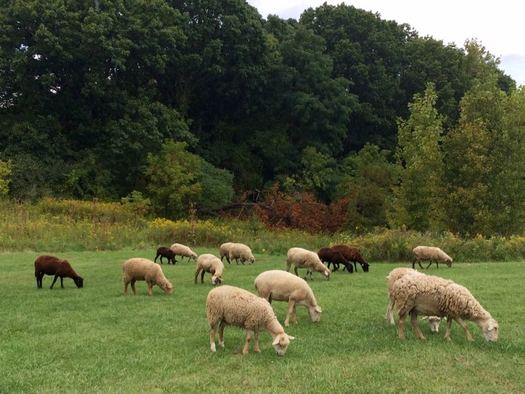
Yep, this is the city of Albany.
Among the newest residents of Albany's Tivoli Lake Preserve: sheep.
The small flock is there now as part of the Tivoli Preserve Community Farm project. The goal is to build a working farm and community programs in the park on the north side of Albany -- and there's been a lot of progress in recent months.
"It's just moving really quickly with help now," said Melissa Parade, the founder of the farm project, when we stopped by last week. "It feels really good."
Here's some quick follow-up on what's happening. And a lot of sheep pics.
Pick-your-own blueberry season 2017
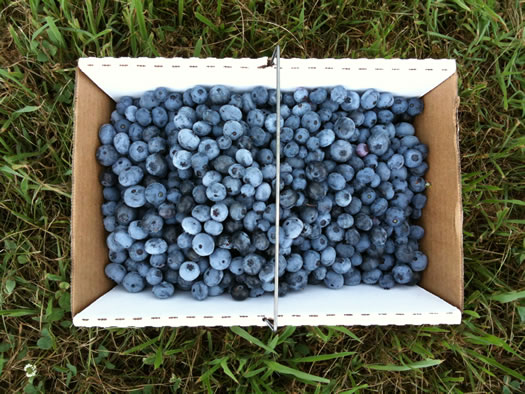
Blueberry season has begun around the greater Capital Region. And there are a bunch of places where you can pick your own.
Blueberries are just about our favorite PYO crop because they're easy to pick (on bushes about waist high), relatively cheap (usually about $3 per pound), and they freeze beautifully, so you can stock up for later in the year.
Here's a list of farms around the region for PYO blueberries, along with a few details.
Follow up: Farm on Peaceable Pastures

Melissa Parade and Fleet, the border collie. (Fleet apparently wasn't keen on having his picture taken.)
AOA is on summer break this week. So we'll have new follow-ups this week with people we've met and covered during the last year.
We first met Melissa Parade as part of the AOA Startup Grant contest last fall. She's been working to start a farm and community programs at the Tivoli Lake Preserve in Albany.
In the time since, she's assembled a herd a sheep that she's been keeping at Albany's Normanskill Farm. And in just a few weeks they'll be making the move over to Tivoli as The Farm on Peaceable Pastures.
We met up with Melissa at a barn just up hill from the Normans Kill last week to talk about the challenges of becoming a farmer, shaping a business plan, and the occasional errant sheep.
Pick-your-own strawberry season 2017

Strawberry season has arrived! Many local farms just opened pick-your-own strawberry fields this week, and others will be doing so shortly.
All that cold, cloudy, wet weather a few weeks back held up this year's crop. Multiple farms have noted that things are a bit behind schedule. But it sounds like the recent sunny weather has things rounding into shape.
A typical strawberry season at many farms in this area only lasts a few weeks, though some farms have strawberries for longer stretches -- even most of the summer -- because their fields include a range of varieties that produce at different times. When you're at the farm stand, ask about the varieties the farms are growing. In our experience people are happy to talk about what's available, for how long, and why. It's also a good idea to call ahead or check the website before heading out.
Here are a handful of places in the greater Capital Region that you can pick your own strawberries. Know of a good place not on this list? Please share!
CSA fair at Takk House

This could be a good way to learn more about CSAs if you're been curious: Takk House in Troy is hosting a CSA fair April 15 from 11 am-2 pm. The event is a collaboration between the Hudson Valley CSA Coalition, Hudson River Exchange, and Glynwood.
CSA = Community Supported Agriculture, in which you pay at the beginning of the season for a share of a farm's produce and then get regular allotments during the season. Event blurbage:
CSA Fairs provide an opportunity for local residents to learn about the vital role Community Supported Agriculture plays for independent farms, to shop around the various shares available and sign up for their Seasonal Share. From fruits and vegetables to herbal wellness to meat and dairy, CSA shares offer community members access to the diversity of farm fresh products - and land based wisdom - that make Hudson Valley living plentiful and enjoyable.
The event at Takk House will include reps from Colfax Farm, Denison Farm, Field Apothecary, Laughing Earth Farm, Roxbury Farm, and Soul Fire Farm. Also: "Remember to bring your checkbook for share deposits and be entered to win on-site sign up giveaways when you buy a share at the event."
Hudson River Exchange advertises on AOA.
photo via Hudson Valley CSA Coalition Facebook
Pick-your-own blueberry season 2016

Blueberry season recently started around the greater Capital Region. And it is an Official Summer Thing To Do.
Blueberries are just about our favorite pick-your-own crop because they're easy to pick (on bushes about waist high), relatively cheap (usually about $3 per pound), and they freeze beautifully, so you can stock up for later in the year.
There are a handful of farms around the Capital Region that offer pick-your-own blueberries. Here's a list with some info. And, of course, if you know of a place that should be on the list, please share.
Your new career in urban shepherding
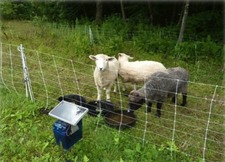 Filed under jobs that you could have: The planned project to graze sheep at Albany's Tivoli Preserve is in search of a shepherd. From the job listing:
Filed under jobs that you could have: The planned project to graze sheep at Albany's Tivoli Preserve is in search of a shepherd. From the job listing:
Aspiring shepherd wanted for the New York State Conservation Grazing (NYSCoG) Program. The shepherd will manage a flock of sheep at the 80 acre Tivoli Lake Preserve in Albany, NY. NYSCoG seeks to help young and beginning farmers gain access to land and infrastructure, and to begin grazing enterprises, while simultaneously assisting municipal, county and state governments in meeting vegetation management goals. The shepherd will receive the use of land, a flock of sheep, summer and winter housing for the sheep, fencing, winter hay, meds, and insurance, and will participate in grazing and pasture management planning. The shepherd will own the agricultural products of the enterprise (lambs, wool). Project begins in July 2016. Contact Dr. Gary Kleppel at Longfield Farm, 518 362 6576 or gkleppel@albany.edu
If Gary Kleppel's name rings a bell, you might remember that he's the UAlbany biologist who's been studying the use of grazing animals to combat invasive weeds. A bunch of years ago he ran a similar project at the city's Normanskill Farm. Over at the Times Union, Chris Churchill recently talked with him about the Tivoli project.
And, of course, you know about the city using goats to eat invasive weeds at the Loudonville Reservoir, a project that has continued this year.
About the Tivoli Preserve: The city of Albany has been planning a series of upgrades for the land on the north side of the city between the Arbor Hill and West Hill neighborhoods, and we hear there will be some specific details coming up in the next few months.
(Thanks, Melissa and everyone!)
earlier photo from Normanskill Farm courtesy of Gary Kleppel
Another record year for New York State maple syrup production

Sweet.
New York State set a new modern record for maple syrup production this year, the Cuomo admin announced Friday. The Empire State produced 707,000 gallons of syrup, according to numbers from the from the US Department of Agriculture.
That's up from 601,000 gallons last year. And it keeps New York at the #2 spot nationally, holding off a surging Maine with 675,000. Better luck next time, Pine (Not Maple) Tree State.
New York's increased production this year was in part a result of a longer season -- 36 days on average this year, compared to 26 last year. But the state continues to add taps, too. Its tap count was above 2,500 this year -- the Cuomo admin says that's the highest number since 1946 -- and the count has been rising by a couple of hundred each year for the past few years. (The state's yield per tap has also been rising.)
Of course, Vermont continues to dominate the field, where they're just playing a different game.
Pick your own strawberry season 2016
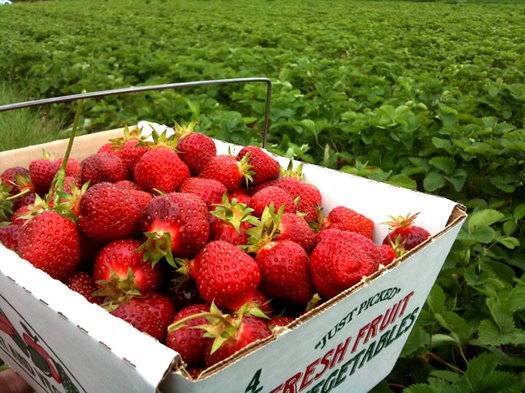
Summer, it is here.
Strawberry season is here! Many local farms are just opening for pick-your-own strawberries, or will be very shortly.
We get the sense this year's crop is maybe a little slow in arriving because of some of the cool weather. And the early warmth in spring further complicated things.
A typical strawberry season at many farms in this area only lasts a few weeks, though some farms have strawberries for longer stretches -- even most of the summer -- because their fields include a range of varieties that produce at different times. When you're at the farm stand, ask about the varieties the farms are growing. In our experience people are happy to talk about what's available, for how long, and why. (It's also a good idea to call ahead or check the website before heading out.)
Here are a handful of places in the greater Capital Region that you can pick your own strawberries. Know of a good place not on this list? Please share!
The buzz on New York honey
 Agricultural fact of the day: New York State produced almost 3.6 million pounds of honey in 2015, according to numbers from the federal government.* That's up almost 9 percent from the year before.
Agricultural fact of the day: New York State produced almost 3.6 million pounds of honey in 2015, according to numbers from the federal government.* That's up almost 9 percent from the year before.
New York's total ranked 10th among all states last year. (It ranked #13 last year.) And it's by the far the biggest producer in the Northeast. (Next up is Maine at #31.)
The state's production was valued at a little more than $10.5 million. The average price per pound that New York producer were able to get was $2.94. (The national average $2.09.)
"Soul Fire Farm: Reclaiming a Tradition of Black Farming" at Albany City Hall
 Albany City Hall will be hosting a presentation by Soul Fire Farm founders Leah Penniman and Jonah Vitale-Wolff this Thursday, April 21. Blurbage:
Albany City Hall will be hosting a presentation by Soul Fire Farm founders Leah Penniman and Jonah Vitale-Wolff this Thursday, April 21. Blurbage:
Soul Fire Farm in Grafton, new York was born in Albany's South End in 2006. Soul Fire is both a beautiful working farm and a unique, nationally recognized educational center. Leah Penniman and her husband Jonah Vitale-Wolff's mission is rooted in a commitment to fighting racism and dismantling oppressive structures that misguide our food system. Using strategies like day-long educational workshops to reconnect youth to their innate belonging to land, leah is working so that everyone, regardless of class, color, or creed, has access to fresh, healthful food and an understanding of how to grow their own. This will be a lively presentation and discussion about the connections between producing healthy food, youth empowerment, and social justice.
Here's a 2014 profile of Soul Fire Farm over at Civil Eats that includes some more backstory.
The event is Thursday starting at 5 pm in the city hall rotunda. It's free.
photo via Soul Fire Farm website
Suggestions and advice on local CSAs?

Carrie emails:
Wondering if you guys could do another post on CSA's this year...? I know you did one in 2009, I remember every time I search for updates and that comes up. And the Times Union did something in 2013. But this seems like a growing thing, and (I hope) there have been some new ones and some changes to old ones?
CSA stands for "community supported agriculture" (people also refer to them as farm shares). The way they basically work: People the farm upfront at the start of the growing season and then they get a batch of farm produce at some interval (usually weekly) throughout the season.
This is currently prime time for CSA signs-ups, and many of them fill up.
As those links above indicate, there are a bunch of CSA options in the Capital Region. So... have one you'd recommend? Any advice on picking one that's a good fit for a household? Tips on working through all that produce each week? Thoughts on sharing a share with another household?
If you have suggestions for any of those questions, please share! And as always, a sentence or two about why're suggesting something can be a big help.
New York State Maple Weekend 2016

The annual New York State Maple Weekend(s) are coming up later this month -- March 19-20 and April 2-3. What are these weekends and why are they so sappy? Blurbage from the New York State Maple Producers Association:
Every spring, the members of the New York State Maple Producers Association invite families and friends into their "sugar houses" to experience the world of pure NY maple syrup. Located at approximately 160 farms and museums across New York State, Maple Weekend offers a delicious, fun-filled outing that has a little something for all maple-lovers to taste and experience.
There are a bunch of participating spots around the greater Capital Region. Many of the producers offer free samples and tours, and there will be maple products for sale, of course.
The maple sap season is dependent on the temperature -- this year's season got an early start because of the mild winter. So if you're interested in going to one of these places and seeing everything in action, the first weekend could be a better bet than the second.
State of maple: New York State is the nation's second biggest producer of maple syrup (after Vermont) -- and last year it produced a record amount, more than 600,000 gallons.
Earlier on AOA: The art and science of maple sugaring
Pancake breakfast at The Sap House at Stone House Farm
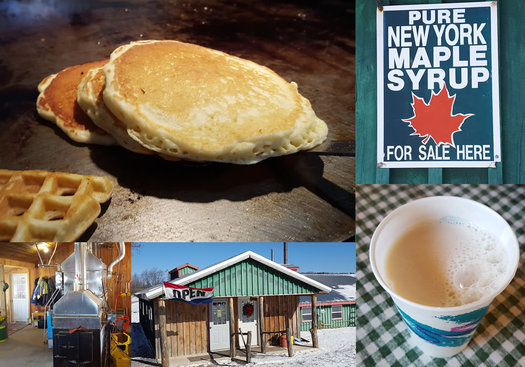
I recently had dinner with a group of friends -- all but one of us an "outsider" to Albany, growing up elsewhere -- about what it is that makes the city so alluring to us. Why we feel Albany is primed for a resurgence as a modern city where young(ish) people like us can thrive, have families, lay down roots. (And by Albany, what we really meant is both the city and the surrounding area we refer to as the Capital Region.)
Part of the appeal, for us, is the fact that there is just so much to do here. Within a three hour drive, we can experience mountains, lake, ocean, cities, other countries. And in considerably less time, we can be transported to the bucolic countryside for leisurely weekend drives that highlight the agricultural and small-town economies that give the Capital Region much of its charm.
Case in point: Sharon Springs. The town lies on the historic byway of US Route 20 and was once a hotspot for the out-of-towners looking for healing qualities in the town's natural springs. And there are plenty of farms surrounding the tiny town center that offer a plethora agricultural products that city-folk are more than happy to bring home.
Like maple syrup. And really, what's the point of maple syrup if you can't have a good pancake to sop it up with?
New Year's brunch/farm tour at Heather Ridge Farm
 This could be something a little different to round out the holidays: Heather Ridge Farm in Preston Hollow is offering a farm tour and brunch buffet the weekend after New Year's Day. Blurbage:
This could be something a little different to round out the holidays: Heather Ridge Farm in Preston Hollow is offering a farm tour and brunch buffet the weekend after New Year's Day. Blurbage:
The brunch buffet will feature many items including caramelized French toast, maple chipotle breakfast sausage, eggs to order, Dublin Coddle, Irish Brown bread and many more items. Many of the items on the buffet were raised and made on the farm, including the pork sausages, grassfed corned beef hash, no nitrate bacon in the Dublin Coddle and the eggs. Heather Ridge Farm is certified Animal Welfare Approved. ...
The farm animals will be in their winter quarters. Among the animals to see are goats, sheep, llamas, alpacas, donkeys, laying hens, geese and guinea fowl. The tour will last approximately an hour.
The brunch is $24 per person (kids pay their age), and the tour is included. It's Saturday, January 2 and Sunday, January 3 from 11 am to 3 pm -- reservations recommended. The farm is located just a bit over the Albany County line in Schoharie
If the name Heather Ridge Farm rings a bell, it's the same farm that provided the goats for the "goatscaping" project at Albany's Loudonville Reservoir. And the farm has also been offering a series of monthly supper club dinners, of which we've heard many good things.
photo: Heather Ridge Farm
How raising steer has changed the way I eat
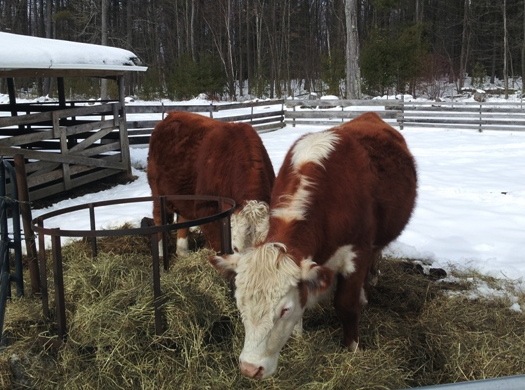
Back in the 70s and early 80s, my father-in-law raised animals. Steers, a few pigs, turkeys, and the freezer often had some hunted venison. Most of that had stopped by the time I started hanging around in the early 90s.
In December of 2003, the first case of mad cow disease was discovered in the US. A few weeks later at a New Year's party, my father-in-law asked, "If I did cows again, would you want in?"
Being a little too into all things food -- and a bit drunk -- I was game. And I'm glad I was. Because there is no doubt the experience has changed the way I cook and eat.
Defining an upstate cuisine
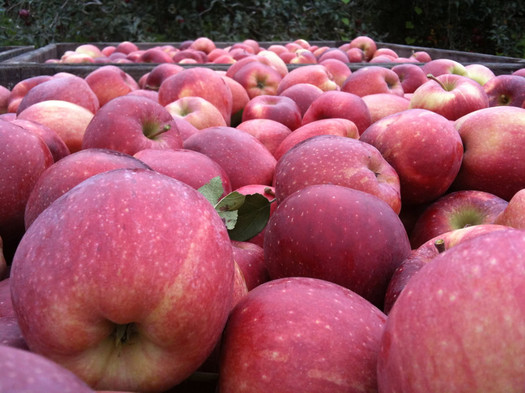
Apples, sure. But the bounty of great local products extends far beyond that.
With the harvest from this past summer finishing up, and Thanksgiving just ahead, we figured it would be a good time for some thinking and discussion about local food. So, it's Following Food Week here on AOA.
Is there an Upstate New York Cuisine?
Sure, in the Capital Region we have mini hot dogs, foot-long fish fry, and mozzarella with melba -- but that's not quite a cuisine, per se. And we have a strong tavern culture, but regardless of how soul satisfying a cheesy, doughy, saucy, tavern pie may be in the midst of winter, it doesn't provide the flavor of the region.
Many regional cuisines are based on the unique combination of local ingredients that are available in the area. And here, at the intersection of the Hudson and Mohawk rivers, surrounded by farms, woods, and mountains, we have plenty of raw materials from which to draw inspiration.
So, with that as a starting place, we asked some talented chefs: "What would an Upstate New York Regional Dinner menu look like?"
Re-growing the local grain industry
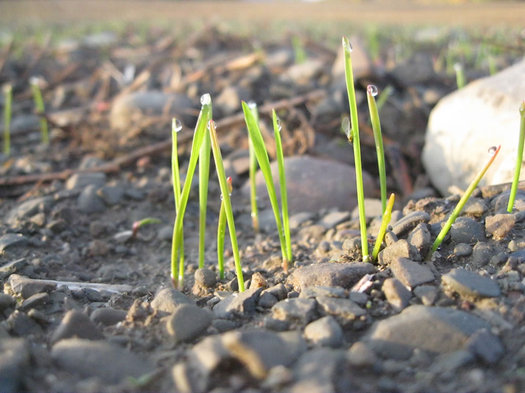
Amy's favorite pastry wheat is planted in the fall near Ithaca.
With the harvest from this past summer finishing up, and Thanksgiving just ahead, we figured it would be a good time for some thinking and discussion about local food. So, it's Following Food Week here on AOA. We start things off with a look at the effort to re-grow this area's grain industry.
Grains are so foundational and basic that we don't give them much thought. I certainly never gave them much mind, even though I'm a heavy baker.
Until five years ago, I had two facts about flour: I knew I liked King Arthur, and that I loved the taste of whole wheat.
Then, I had a cookie that introduced me to fresh, locally-grown oats and wheat. The flavors were so vibrant I had to follow that food back to the field.
And I'm here to report that the road to local wheat is tough traveling.
When New York was hopped up
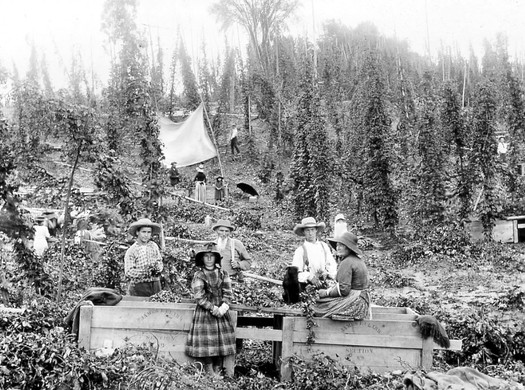
The photo above is from the NYS Archives, and it's from a hop farm near Cooperstown around 1900.
Hop farm? You know it. From the accompany description on the archives site:
In Ostego County in the town of Madison, New Yorker James D. Coolidge planted the first hops yards in 1808. His commercial opportunity came fourteen years later when blight, insects, and unfavorable weather decimated crops in England. This increased the demand for New York's hops in both national and international markets.
The opening of the Erie Canal in 1825 and the influx of German immigrants during the first half of the nineteenth century also increased the domestic demand for hops. In 1850, New York shipped 750,000 pounds of hops to British markets. In 1880, all but sixteen New York counties were growing hops. Ostego, Madison, Herkimer, Schoharie, Chenago, Oneida, and Montgomery Counties were the leading producers of hops, with Ostego County producing more hops than any other county in the United States.
Disease and Prohibition pretty much killed off the hop growing industry in New York, and today most of the hops grown in the country are produced out in the Pacific Northwest.
But the crop is making a comeback here, a rise prompted in part by the state's farm brewery license, which requires breweries operating under the license to use a certain percentage of New York-grown ingredients. Casey wrote about the rebirth of the New York hop industry a few years back.
Among the local farms that are part of the re-hopped New York is Indian Ladder Farms in Altamont, which is growing a variety of hops. (You might remember the Indian Ladder Farms IPA at the Pump Station last year.) ILF recently finished this year's hop harvest and posted some photos of the process on its Facebook page.
photo: NYS Archives
FarmieMarket for sale
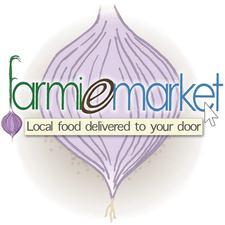 The local online farmers' market FarmieMarket is for sale. Founder Sarah Gordon posted this message on Facebook this week:
The local online farmers' market FarmieMarket is for sale. Founder Sarah Gordon posted this message on Facebook this week:
It's bittersweet, but in effort to balance my growing family life with my professional responsibilities, I have arrived at the very difficult decision to offer my equity stake in FarmieMarket.com up for sale. FarmieMarket is my firstborn -- I am fully committed to seeing it and its member farmers reach their full potential. As such, the time has come to hand over the day-to-day operations and marketing to a person or firm that has the time, resources and expertise necessary to grow the market to its fullest potential. That said, I am eager to stay involved if the buyer is willing (either as a board member, or volunteer advisor) to help guide FarmieMarket in its mission of cultivating a sustainable market channel that supports the long term profitability and economic viability of small, family-owned, environmentally- and socially-responsible local farms. If you, or anyone you know, may be interested in carrying the torch please contact me via email or private message.
Gordon started FarmieMarket in 2010, originally as Heldeberg Market, as a way to market and sell products grown on farms in the Hill Towns of Albany County to a wider audience. (Gordon was inspired by the experience of her family's grassfed beef farm in Berne.) Customers place orders online and the products are delivered one day a week.
Earlier on AOA: Interesting in 2011: Sarah Gordon
Washington County Cheese Tour 2015
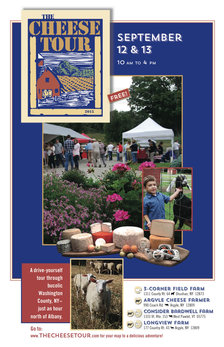 The annual Washington County Cheese Tour returns September 12 and 13. It is pretty much what it says on the label -- a tour of farms in Washington County that produce cheese. Blurbage:
The annual Washington County Cheese Tour returns September 12 and 13. It is pretty much what it says on the label -- a tour of farms in Washington County that produce cheese. Blurbage:
At each farm, guests will sample specially selected cheeses while experiencing first hand the region's long-standing cheese making traditions reaching back to the nineteenth century. All are active farms, raising cows, sheep and goats that supply the milk for the cheese-making process.
A few years back Tim wrote a recap of the tour, which can you give a sense of how it goes. If you like cheese + farms (and farm animals), it's a pretty good bet you'll like the tour.
The participating farms will be open for touring from 10 am to 4 pm on Saturday, September 12 and Sunday, September 13. The tour is free.
Tour preview
On Sunday, August 23 the Honest Weight Food Co-op is hosting a "Meet Your Maker" event to preview the cheese tour. Cheese makers from farms on the tour will be there from from noon-2 pm offering samples and talking about their farms.
Pick-your-own blueberry season 2015

We are into the thick of blueberry season around the greater Capital Region. And as we've mentioned before, blueberries are just about our favorite pick-your-own crop because they're easy to pick (on bushes about waist high), relatively cheap (usually between $2-$3 per pound), and they freeze beautifully, so you can stock up for later in the year.
There are a handful of farms around the Capital Region that offer pick-your-own blueberries. Here's a list with some info. And, of course, if you know of a place that should be on the list, please share.
Sweet: Record maple syrup production in New York State

New York State produced more than 600,000 gallons of maple syrup this past spring, according to numbers from the US Department of Agriculture. That's good for #2 in the nation. And the Cuomo admin says that's the state's highest total in 70 years.
The sappy record is especially notable because this past maple syrup season was just 26 days long. It was 40 days long when the state set its last "modern" record in 2013.
So, what's responsible for the sweet success? From a Cuomo admin press release:
The amount produced is the most since 1944, the last year before the beginning of a long drop-off in the number of tree taps and the yield of syrup per tap. New York's resurgence began in 2008 as vacuum pumping systems began to replace the metal tree taps and hanging buckets that have signified maple syrup farming for centuries.
The New York State Maple Producers Association estimates that 60 percent of maple farms, including most of the larger farms of more than 500 taps, use vacuum systems to collect raw sap. The modern vacuum system is easier for producers to maintain, which has helped increase production per tap. The average tree tap produced a little more than one quart of syrup this year, though some large farms are seeing yields of a half-gallon or more.
New York State is still far behind Vermont for the nation's top spot for maple syrup production. The Green Mountain State produced 1.39 million gallons this spring, according to USDA. (The tiny state's pancake industry is straining under the pressure to keep up.)
Vermont maple syrup is an interesting case because the state has been experiencing some sort of Maple Miracle over the last decade. So much so that Quebec -- the Saudi Arabia of maple syrup -- has been warily eyeing its neighbor to the south.
Pick your own strawberry season 2015

So very June.
Strawberry season is here! Many local farms have recently opened for pick-your-own strawberries, or will be very shortly.
It seems like there's a fair amount of variability across farms this year -- some have gotten an early jump and others are still waiting for their berries. If we get a few sunny days following this rain, things could move along quickly.
A typical strawberry season at many farms in this area only lasts a few weeks, though some farms have strawberries for longer stretches -- even most of the summer -- because their fields include a range of varieties that produce at different times. When you're at the farm stand, ask about the varieties the farms are growing. In our experience people are happy to talk about what's available, for how long, and why. (It's also a good idea to call ahead or check the website before heading out.)
Here are a handful of places in the greater Capital Region that you can pick your own strawberries. Know of a good place not on this list? Please share!
Genetically modified apples move closer to production
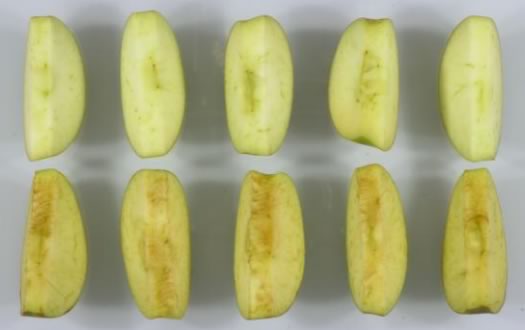
The top row are "Arctic" Granny Smith apples, and the bottom are traditional Granny Smith. / photo: Okanagan Specialty Fruits
Arctic apples -- the apples genetically modified so they don't brown when exposed to air -- have cleared one of their last regulatory hurdles, the US Department of Agriculture announced Friday. [Politico] [USDA]
Okanagan Specialty Fruit -- the company that developed the apples -- is projecting that small test-market quantities of its non-browning Golden Delicious and Granny Smith apples will available by 2016.
The technology used to create the apples is called gene silencing. Basically what Okanagan has done is target genes in the apple that are responsible for producing an enzyme involved in apples browning, and turned those genes off. The company says it's able to silence these genes very specifically. (Here's a skeptical perspective on the precision of the targeting.)
The commercial idea here is that non-browning apples will open up more opportunities for sliced apple snacks, and reduce food waste.
As you know, New York is the second largest producer of apples in the United States. Hearst reported last fall that Arctic apples were being tested at an undisclosed location upstate. Apple growers associations, both national and here in New York, have been skeptical of the genetically modified apples, not so much because of safety concerns but because of worries about how the public will perceive the apples -- essentially, apples already have a rep for being healthy and wholesome, so why do anything that could potentially mess with that. [Hearst/TU] [Modern Farmer]
Beer, grown here
 Interesting: The Albany Pump Station is offering a beer called ILF IPA on tap this week -- the beer was made by C. H. Evans Brewing Company entirely with hops and barely grown at Indian Ladder Farms in Altamont. There's a reception of sorts for the beer this Thursday, December 4 at 5 pm at the Pump Station.
Interesting: The Albany Pump Station is offering a beer called ILF IPA on tap this week -- the beer was made by C. H. Evans Brewing Company entirely with hops and barely grown at Indian Ladder Farms in Altamont. There's a reception of sorts for the beer this Thursday, December 4 at 5 pm at the Pump Station.
Blurbage:
"This excellent hoppy beer shows what New York State brewers and growers can do when they get together," said Dietrich Gehring, who grew the hops and barley on Indian Ladder Farms, in Altamont, New York. Gehring provided the brewery with 500 pounds of malted barley and 25 pounds of hops, including a local heirloom variety called the Heritage Helderberg Hop, which was discovered growing wild on an old farm in Albany County's Hilltown region and is now being propagated by Gehring. The barley was even malted in New York at Farmhouse Malt in Newark Valley.
Check out Greg Back's tour of The Helderberg Hop Farm from last year over at In The Name of Beer.
There are a lot of interesting culinary and historical threads that intersect here. Among them is the attempt to resurrect crops, such as barley and hops, that once thrived in this area (and the history of which goes way back). You know, it's not like you just throw some seeds in the ground -- there's skill and experience and equipment that goes in growing these products. (You might have heard of the Helderberg Brewshed project at the Carey Institute in Renssealerville -- it's aiming to re-cultivate this sort of knowledge and help develop a regional economy to support it.)
Gehring and his wife, Laura Ten Eyck, are currently working on starting the Indian Ladder Farmstead Brewery and Cidery. In the meantime, the've been working with C.H. Evans and Other Half Brewing Company in Brooklyn.
Earlier on AOA:
+ The history of Albany as seen through beer-colored lenses
+ Resurrecting a beer, and part of Albany's history
+ New York hops
photo via Helderberg Hop Farm FB
Beyond boring apples

You never know what you might find inside.
One of the fun things about the Capital Region in the fall is that we're surrounded by apple orchards. And there are all sorts of good things that go along with that: weekend apple picking trips, cider donuts, all that stuff.
But it also means we have access to a wide range of different apples -- way beyond the same 10 or so varieties you see in the supermarket all the time. And given that there are literally thousands of apple varieties, why limit yourself to the same-old Macs, Galas, and (shudder) Red Delicious?
We took a drive out to Samascott Orchards in Kinderhook recently to try some unusual apples.
Official snacking
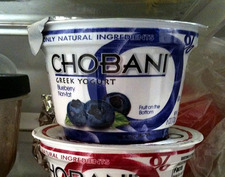 Noted: Yogurt is now officially the official snack of New York State. The Cuomo admin announced Wednesday morning that the governor had signed the bill making it so.
Noted: Yogurt is now officially the official snack of New York State. The Cuomo admin announced Wednesday morning that the governor had signed the bill making it so.
As you well know, New York has been the biggest producer of yogurt the last two years, thanks in part to the Greek yogurt boom and companies such as Chobani and Fage.
The press release doesn't mention anything about the heated debate over whether frozen yogurt would qualify as official snacking if consumed between meals. The Cuomo admin is obviously dodging this important question. (Zephyr Teachout would have put the screws to AC on this question in a debate, no doubt.)
Also: Empire State cottage cheese and sour cream -- call your lobbyists, it's time to get them earning their pay. New York was the #1 producer of both dairy products in 2013. (The Empire State rules cottage cheese.) So where is your official state designation and summit, huh?
Tasting a Snapdragon
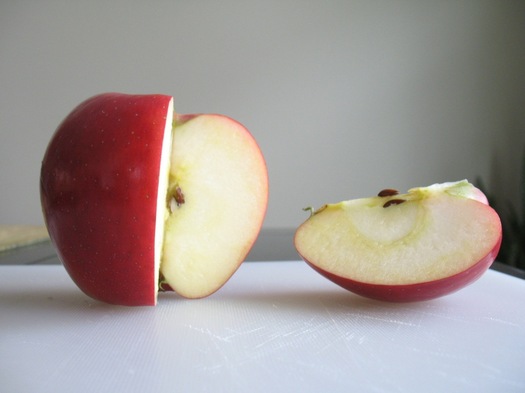
Because apples/autumn/upstate: We finally got a chance to try a Snapdragon apple, one of the new varieties publicly announced last year after being developed at Cornell. We picked a few of them up at the Samascott farm store in Kinderhook.
So, how do they taste? The texture is crunchy, and the flavor has an interesting sweetness. They've been described as having a "spicy-sweet" flavor -- and while we're not sure we'd describe it that way, it's more complex than a flat, uniform sweetness. We enjoyed the apples.
That the Snapdragon is crunchy isn't a surprise -- one of its apple parents is the super-popular Honeycrisp (the other parent is a numbered Minnesota variety). And we'd say the Snapdragon has a more interesting flavor. (Unpopular assertion: the Honeycrisp is overrated and kind of boring.)
Snapdragons are still a year away from being widely available, according to the New York Apple Association. But a handful of orchards in the greater Capital Region are growing them, including Indian Ladder, Goold, Golden Harvest, Samascott, and Bowman.
Apples as brands
The Snapdragon was introduced with the RubyFrost, and they represent a new effort by Cornell to partner with the New York Apple Growers org to license the apple varieties in North America. It fits into a wider trend within the industry to establish individual apple variety brands.
And, sure, that makes business sense. But we have to admit we're not fans of the names and slogans produced by this trend, like "CRUNCH INTO ZESTAR!"â„¢. They don't have the romance/mystery/history of names such as Esopus Spitzenburg, Worcester Pearman, or Cortland.
Earlier on AOA
+ How 'bout them (new) apples?
+ Lost and found apples
Where to get good peaches?
 Julie emails:
Julie emails:
Hey AOA, is there anywhere to go pick your own peaches around the capital region?
For whatever reason, PYO peaches appear to be a rarity around here. Maybe because the fruit is relatively fragile and growers want to make sure their trees are picked with care. Maybe just because peaches aren't as plentiful around here as, say, apples.
That said, there are some places to score good peaches. We have had some really nice peaches from Golden Harvest in Valatie this year. And in the past we've gotten different types of good peaches from Maynard Farms, which sells at the Schenectady Greenmarket.
Know of PYO place for Julie? Or even just a good local farm or farm stand for buying peaches? Please share!
AOA fall event: Farm Tour
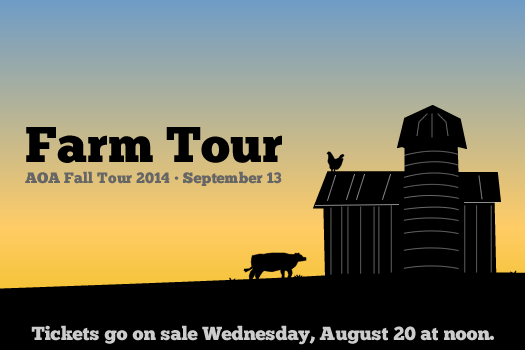
Update: Tickets are now on sale!
____
Summer is cooling down, and while that means bidding farewell to ice cream stand and swimming pool season, it also means welcoming a bounty of produce from local farms.
We thought it'd be fun to visit some of those farms early this fall, so we've organized a farm tour through the Helderbergs. The tour is September 13. Tickets are $40 and will go on sale this Wednesday (August 20) at noon. Capacity is limited. And as with AOA's past tours, they will probably sell quickly.
The tour will visit three farms so we can meet the farmers and hear their stories. We'll also get to see cows, chickens, and pigs; sample produce right where the food is grown; and visit a brew shed (and try some beer). We'll finish the tour with some snacks made from locally-sourced ingredients.
It should be a fun early fall day. Here's are a few more details, along with an outline of the schedule.
Washington County Cheese Tour 2014
 The annual Washington County Cheese Tour is coming up in less than a month -- it's September 6 and 7 this year. It is pretty much what it sounds like: a self-guided tour to a handful of cheese-making farms in Washington County (and one in Vermont).
The annual Washington County Cheese Tour is coming up in less than a month -- it's September 6 and 7 this year. It is pretty much what it sounds like: a self-guided tour to a handful of cheese-making farms in Washington County (and one in Vermont).
It is, by the accounts we've seen, an interesting and (literally) cheesy time. As Tim recapped the tour a few years back:
Crowds from around the area came to taste locally made cheeses and other dairy products right where they're made. Right. Where. They're. Made. I mean the animals whose milk helped to create the delectable products being sampled actually look on while you toothpick your way through lines of delicious, tangy, cheesy goodness. ...
I sampled some of the best, most complex cheese I have tasted in a long time. It's amazing to me how many different flavors artisan cheese makers can pull out of milk. The cheeses ran the gamut from hard, soft, pungent, and mild, raw, pasteurized, aged, and young. One thing united them, though. They were all delicious. And while the cheese event is only once a year, you can get the cheeses year round.
The participating farms will be open September 6 and 7 from 10 am-4 pm. The tour is free.
Cheese tour preview: The Cheese Traveler in Albany is hosting a tour preview at its shop on Delaware Ave this Thursday (August 14) from 5-7 pm. Blurbage: "Come meet the cheesemakers and enjoy cheeses from five Washington County creameries, paired with beer from Rare Form Brewery and accompaniments by The Cheese Traveler." It's $25 per person.
The Cheese Traveler advertises on AOA.
photo: Tim Dawkins
Pick-your-own blueberry season 2014

Blueberry season has started around the Capital Region, and we'll soon be right in the prime part of the season. Blueberries are are one of our favorite fruits to pick because:
1) The bushes grow about waist or chest high, so there's not a lot of bending or reaching.
2) The berries tend to be cheap -- usually between $2-$3 dollars per pound.
3) They freeze beautifully, meaning we can load up on berries during the summer and enjoy them months later.
There are a handful of farms around the Capital Region that offer pick-your-own blueberries. Here's a list with some info. And, of course, if you know of a place that should be on the list, please share.
Rare spitters
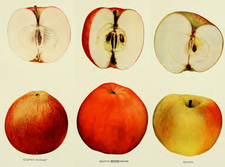 Over at Reuters there's an interesting article on a nationwide shortage of bittersweet, bittersharp, and sharp apples that have traditionally been used to make complex hard ciders. These so-called "spitter" apples are in demand because of the cider boom -- but there's a tiny supply because the apple varieties (many are heirlooms) fell out of favor over the last century or so:
Over at Reuters there's an interesting article on a nationwide shortage of bittersweet, bittersharp, and sharp apples that have traditionally been used to make complex hard ciders. These so-called "spitter" apples are in demand because of the cider boom -- but there's a tiny supply because the apple varieties (many are heirlooms) fell out of favor over the last century or so:
One reason for the apple shortage is historical. During Prohibition in the 1920s, trees known to bear hard cider apples became targets of axe-wielding FBI agents.
Popular bittersharp varieties include Kingston Black, Foxwhelp and Golden Russet. These are not dessert or eating apples such as Granny Smith.
Planting new orchards is a big commitment. An apple tree is a 25- to 30-year investment and it takes anywhere from three to six years before it becomes productive.
Greg Peck, assistant professor of horticulture at Virginia Tech University, said there are no figures for how many so-called spitters - apples too tart or bitter to eat fresh but perfect for cider making - are available currently.
In 2012, the total U.S. crop of apples was 216 million bushels, of which 1.7 million were used to make cider. Of that, Peck estimated, "only a handful" of those were bittersweet, bittersharp or sharp varieties.
While the article doesn't mention New York specifically, it indirectly points to another possible Empire State advantage for cider: orchards around here do seem to grow some unusual varieties. (We've picked Golden Russets at Samascott in Kinderhook.)
Earlier on AOA:
+ Lost and found apples
+ More fizz for the cider business in New York
Illustration from The Apples of New York State of New York Department of Agriculture (1903)
Pick your own strawberry season 2014

Always a happy sight.
Strawberry season in the greater Capital Region has arrived! Many local pick-your-own farms are now open for the season.
Many farms just opened PYO during the last week or so. The cold spring and some of the rainy weather of late has apparently held back -- or sort of paused -- many of the strawberry fields. But the recent run of sunny, warm weather has things picking up, and this coming weekend is looking like prime berry picking.
A typical strawberry season at many farms in this area only lasts a few weeks, though some farms have strawberries for longer stretches because their fields include a range of varieties. (It's always a good idea to call ahead or check the website before heading out.)
Here are a handful of places in the greater Capital Region that you can pick your own strawberries. Know of a good place not on this list? Please share!
Reign of the Yogurt Empire State continues
 New York State was once again the largest producer of yogurt in the country in 2013, the Cuomo admin reported Tuesday based on numbers from the federal government. It's the second straight yogurt production title for the Empire State, besting California both last year and in 2012.
New York State was once again the largest producer of yogurt in the country in 2013, the Cuomo admin reported Tuesday based on numbers from the federal government. It's the second straight yogurt production title for the Empire State, besting California both last year and in 2012.
New York factories produced 741 million pounds of yogurt in 2013, according to the Cuomo admin's quoting of USDA stats (it doesn't appear the state by state numbers have been posted yet). That's up almost 7 percent over the year before. For 2013, NYS was responsible for about 16 percent of the national production total.
The Empire State's reign is attributed to the Greek-style yogurt boom. Both Chobani (the #1 brand) and Fage (the #2 brand) have plants in the state. (The Chobani plant near Oneonta is said to make a million pounds of yogurt a day.)
By the way: The Cuomo admin reports New York was also the third biggest producer of milk in 2013, and the biggest producer of both cream cheese and cottage cheese.
The Virtual Veggie Mobile
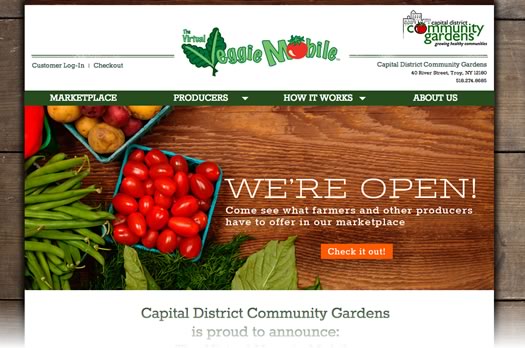
A screengrab from the site.
The Capital District Community Gardens org is starting a new venture: the Virtual Veggie Mobile. It's an online marketplace to connect local farms with local wholesale buyers, such as schools, hospitals, and restaurants. From a press release:
Local farmers often struggle to market their products to chefs and other wholesale consumers, with whom their schedules conflict. The Virtual Veggie Mobile provides a way for consumers to communicate with farmers and shop local markets when it is convenient for them. The site gives farmers the advance notice they need to produce only what is in demand, eliminating the risk of food waste. CDCG will take on the responsibility of delivering orders, enabling farmers to spend less time away from their crops.
One of the things we've heard from a few local farmers and restaurateurs in the past is that the prices all the players are seeking don't necessarily match up. Basically, many smaller-scale local farms are looking to sell their products at retail prices, but restaurants are looking to buy them at wholesale prices. (Obviously some of the players find a way to make it work because local farm ingredients do show up on local restaurant menus.) So it will be interesting to see if this marketplace can help smooth out that gap.
CDCG says the Virtual Veggie Mobile will also eventually allow low-income families to purchase products through the marketplace.
It's kind of remarkable that this area has three online local farm products services, now with the addition of the Virtual Veggie Mobile. It joins the already-established -- and more end consumer focused -- services FarmieMarket (an online farmers' market) and FieldGoods (sort of like a virtual CSA service).
Earlier on AOA:
+ A look at the plans for the Capital District Community Gardens Urban Grow Center
+ Your Veggie Mobile questions answered (2009)
New York, honey
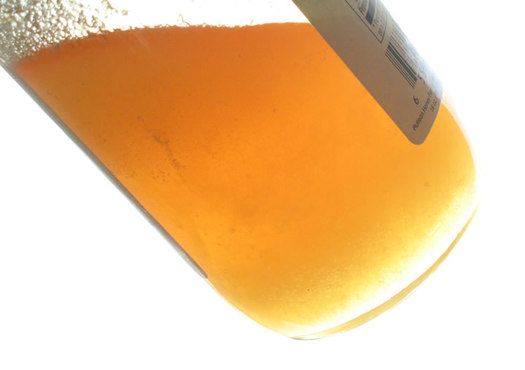
This honey's from Amsterdam.
Agricultural fact of the day: New York is 16th in the country for honey production, and by far the biggest producer in the Northeast. The Empire State produced 2.6 million pounds of honey last year, worth about $5.3 million, according to the USDA.
We came across these facts today after seeing word that the FDA has proposed stricter rules on what can and can't be called honey. The rules are in response to accusations that some producers -- especially in other countries -- have been cutting their honey with sweeteners such as rice syrup, and that "honey" is finding its way into this country. Chuck Schumer, in buzzing about his own efforts on the issue, referred to the practice as "honey laundering." [Minn Post] [Chuck Schumer office]
There's been some concern about funny honey business for a few years. Last year one of the nation's largest packers of honey admitted it had been involved in a mislabeling scheme in order to import cheap honey from China. Imports from that country have been subject to heavy taxes for the last decade after the feds decided China was dumping honey here at artificially low prices. As a result, illegal schemes cropped up for getting the stuff into the US. [NPR x2] [Bloomberg Businessweek]
By the way: North Dakota is far and away the largest producer of honey in the country, according to the USDA. It's 33 million pounds of honey was more than twice that of Montana and South Dakota's totals at #2 and #3.
Given the other stuff that comes through here from North Dakota, we're kind of wondering now why we can't (also) have a honey transfer depot at the Port of Albany.
Would you drink tree sap?
 So this is a thing, apparently, and it's a thing from New York that will be showing up in stores in this month: maple water.
So this is a thing, apparently, and it's a thing from New York that will be showing up in stores in this month: maple water.
You know another word for maple water? Sap. Not boiled down into syrup. Just "minimally" processed sap.
From the Cornell Cooperative Extension, which assisted in developing the product:
As temperatures warm and maple sap starts flowing, gallons of it are collected and boiled down to make syrup. But the subtly sweet watery sap also tastes great straight from the tree, said Michael Farrell, director of Cornell's Uihlein Forest in Lake Placid and author of a recently released comprehensive maple guide, "The Sugarmaker's Companion."
"I love drinking the sap - it's absolutely delicious," Farrell said. ...
If the popularity of coconut water is any indication, there could be a big market for an all-natural product that is mostly water with a bit of sweetness and minerals, Farrell said. In taste tests conducted at Cornell's sensory laboratory, participants preferred maple water to coconut water, he added.
The success of the product would be a big boon to the state's maple producers and forest owners, Farrell said. Cugnasca is now working with members of the New York Maple Producers Association near its western New York bottling plant to supply sap for the first batches of Vertical Water.
As mentioned above, the commercial product is called Vertical Water, and it comes in one of those Tetra-Pak containers with a screw top. Also, from the company website: "The ideal temperature for drinking it is the temperature when it first comes out of the tree: around 40°F."
How does it taste? Over at Slate, L.V. Anderson writes (asterisk added): "It tasted like ... slightly sweet water.* The maple flavor was so mild as to be almost impossible to discern." And a tester for Business Insider concluded: "All it needs is vodka."
Why do we get the feeling Canada is laughing at us right now.
____
* As for sweetness, Vertical Water says its maple water has 3 g of sugar per 8 fluid ounces (and 15 calories). For comparison, Coke has about 26 g of sugar per 8 oz, and orange juice has 21 g. (Different types of sugar have different apparent sweetness, so this is just a sort of rough frame of reference.)
Earlier on AOA:
+ A new way of producing maple syrup: "like a sugar-filled straw stuck in the ground"
+ The art and science of maple sugaring
photo: Vertical Water
Today's moment of... almost spring

Hello there.
This calf was born this week at Gordon Farms in Berne. It's calf season there. Sarah Gordon -- her dad, Sandy Gordon, owns the farm, -- snapped the photo. She says they're expecting 22 calves on the farm between now and early April. The Angus-Hereford are usually 65-75 pounds when they're born.
Gordon Farms raises grass-fed cattle. (Their beef is available through FarmieMarket.) We got a tour a few years back, and visited the cows out in the pasture.
Baby animals. Spring must be near.
A look at the plans for the Capital District Community Gardens Urban Grow Center

The CDCG' new Urban Grow Center building on River Street in Troy.
A few years ago the 100-year-old manufacturing building at 594 River Street in Troy was home to a company that produced that little liquid piece that goes inside levels. By this time next year it's expected to house a low-cost produce market and it will be home to the Capital District Community Gardens headquarters.
And a few years from now, if all goes according to plan, the building and the land beside it will also include a hydroponic garden, educational and job training space, and a commercial kitchen.
CDCG executive director Amy Klein says the new Urban Grow Center is unique -- a space that will combine urban agriculture, education, and food access.
A new way of producing maple syrup: "like a sugar-filled straw stuck in the ground"
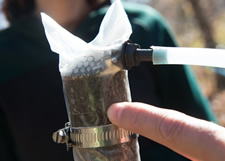 Interesting: Researchers at the University of Vermont's Proctor Maple Research Center -- Tim Perkins and Abby van den Berg -- have stumbled across a new, and potentially "revolutionary," way of harvesting sap for maple syrup. From a November 2013 UVM news article by Joshua E. Brown:
Interesting: Researchers at the University of Vermont's Proctor Maple Research Center -- Tim Perkins and Abby van den Berg -- have stumbled across a new, and potentially "revolutionary," way of harvesting sap for maple syrup. From a November 2013 UVM news article by Joshua E. Brown:
Their new technique uses tightly spaced plantations of chest-high sugar-maple saplings. These could be single stems with a portion -- or all -- of the crown removed. Or they could be multiple-stemmed maples, where one stem per tree can be cut each year. Either way, the cut stem is covered with a sealed plastic bag. Under the bag, the sap flows out of the stump under vacuum pressure and into a tube. Voilà , huge quantities of sap.
In short, these plantations can allow maple syrup production in a farm field.
Typically, a traditional sugarbush produces about 40 gallons of maple syrup per acre of forest by tapping, perhaps, 80 mature trees. With this new method, the UVM researchers estimate that producers could get more than 400 gallons of syrup per acre drawing from about 6,000 saplings. ...
"We got to the point where we should have exhausted any water that was in the tree, but the moisture didn't drop," says Perkins. "The only explanation was that we were pulling water out of the ground, right up through and out the stem." In other words, the cut tree works like a sugar-filled straw stuck in the ground. To get the maple sugar stored in the trunk, just apply suction.
Over at Modern Farmer this week, Laura Sorkin -- a maple producer in northern Vermont -- reflects on some of the possible implications of this new method, which could eventually offer cheaper production and protection against the effects of climate change and the Asian Longhorn Beetle. But also:
[T]he news of the plantation system has been a lot to chew on since we learned of it. We are relatively new to the trade but have come to love it, one of the principal reasons being our interaction with the thousand acres of forest behind our home. Like Dave Folino, I fear that the industry will no longer be special to New England but will be usurped by entrepreneurs anywhere with the right climate. And on a more visceral level, I feel that maple syrup is and should remain a product of the wild. Aside from mushrooms and game meat, the woods of Vermont hardly yield anything edible. And yet, this exquisite sugar can be extracted from the trees while still leaving them healthy and the forest a home to everything from rare wildflowers to bob cats. For me, knowing its origins elicits an amount of pleasure equal to tasting its unique flavor when I drizzle it over morning pancakes. Finally, I ponder what will happen to the acres of working forests if landowners are no longer making an income from them through tapping the trees. It would be unrealistic to expect all of those landowners to choose conservation.
Vermont is the country's leading producer of maple syrup -- it produced 1.32 million gallons of syrup in 2013. The #2 state? New York, at 574,000 gallons last year. [USDA]
photo: Sally McCay / UVM
[via Kottke]
Altamont Vineyard & Winery
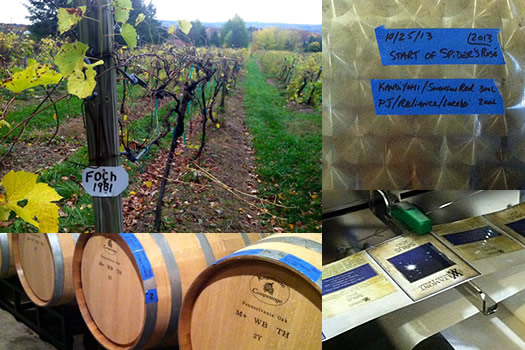
The leaves have turned, the sun's setting earlier, and the air grows colder. It's wine season, folks. Time to hide from the cold by crowding into a cozy winery and warming yourself with sips of Riesling.
And, as it happens, a winery might be closer than you think. The Altamont Vineyard & Winery -- llocated along the Albany/Schenectady county line -- is a small venue that's been in operation since 2006.
But its grapes were established long before that.
Chuck Schumer making a push for hard cider
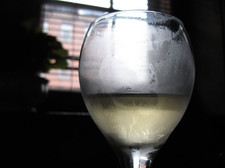 Chuck Schumer was at Golden Harvest in Kinderhook today pushing for legislation that would change the way the feds regulate and tax hard cider. Zzzzzzzzz... yeah, doesn't sound super exciting, but this clip from the press release explains why it could be important (emphasis added):
Chuck Schumer was at Golden Harvest in Kinderhook today pushing for legislation that would change the way the feds regulate and tax hard cider. Zzzzzzzzz... yeah, doesn't sound super exciting, but this clip from the press release explains why it could be important (emphasis added):
Schumer was joined by Golden Harvest Farms owners Alan and Derek Grout as he launched his proposal, the CIDER Act (Cider, Investment & Development through Excise Tax Reduction Act), to update the definition for hard apple and pear cider in the Internal Revenue Code (IRC) that would increase their allowed alcohol by volume from 7 percent to 8.5 percent, encompassing significantly more hard cider products and allowing them to be labeled and taxed like hard cider, rather than wine. Schumer's proposal would also address existing tax issues related to carbonation levels in hard cider, and would put the new definition in line with that of the European Union, so producers can better compete with European products abroad. Hard cider is a value-added product that is sold around the same price every year; therefore hard cider gives producers a stable source of income when apple crops suffer due to weather and other unforeseen factors. New York apple producers are increasingly interested in producing smaller, artisanal batches of hard cider, but cite the cost and difficulty to comply with the IRC definition as significant impediments to expanding their businesses.
New York is the second largest apple producer nationwide, harvesting a total of 29.5 million bushels annually from over 650 farms and 41,000 acres across the state. In recent years, thanks to the growing popularity of hard cider, many apple producers have turned to producing this craft beverage as a method to keep apple orchards profitable, generate new economic development opportunities, and attract a new visitor demographic to their farms. There have been an increasing number of hard cider producers as a result, starting with a few producers a few years ago to over 20 today. And Schumer highlighted that number should only continue to grow, as a significant number of apple farmers are interested in adding this popular product, and have sought out advice and expertise from the Cornell Cooperative to do so.
So, short story: Changing the federal rules could make it easier financially for orchards to make cider -- which could help provide new revenue to keep orchards going, and provide the rest of us with something interesting to drink.
Golden Harvest/Harvest Spirits: Schumer was at Golden Harvest because of its Harvest Spirits distillery, which already makes excellent spirits from apples (and other fruit) -- and it sounds like Harvest Spirits is also interested in getting into the hard cider business, as well.
Earlier on AOA:
+ More fizz for the cider business in New York
+ Nine Pin Cider Works in Albany
+ Eat this: Old Sin Cider from Slyboro Ciderhouse
+ Eat this: Peach Jack from Harvest Spirits
+ Poking around at Harvest Spirits
Raising a farm brewery incubator in Rensselaerville
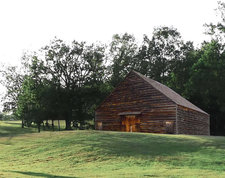 The craft beer/spirits industry is booming, and there's a been a lot of attention over the last few years in New York State on "farm" breweries, distilleries, wineries, and (most recently) cideries. The state has passed legislation that makes it easier/cheaper for these small scale operations -- if they use a specified amount of agricultural products from New York. The goal is to help foster an end-to-end industry in the state: crops are grown here, products are made here, and they're sold here.
The craft beer/spirits industry is booming, and there's a been a lot of attention over the last few years in New York State on "farm" breweries, distilleries, wineries, and (most recently) cideries. The state has passed legislation that makes it easier/cheaper for these small scale operations -- if they use a specified amount of agricultural products from New York. The goal is to help foster an end-to-end industry in the state: crops are grown here, products are made here, and they're sold here.
But that means getting a lot of different people -- farmers, brewers, economic development orgs -- moving in the same direction. Toward that goal, the Carey Center for Global Good in Rensselaerville is starting a "farm brewery incubator." Blurbage:
For the past year, the Carey Institute has been working to start a model farmstead brewery in Rensselaerville. The aim of the project is to create a new economic development and social networking hub, bringing farmers, brewers and the Capital Region community together.
The Carey Institute has partnered with CSArch, an Albany architecture firm, to reconstruct a 1760's New World Dutch barn donated by Randolph J. Collins from the town of Guilderland. This icon of local history will be erected on our campus and adapted to house New York State's first farm-to-glass classroom and farm brewery incubator. Here, we will provide start-up brewing space and educational opportunities to emerging farm brewery enterprises, cultivating economic opportunities for farmers and brewers in New York State's budding farm-to-glass industry.
The Carey Center has a kickoff fundraising event for the project lined up for November 16, from 5-6:30 pm.
So why does this sort of project matter? Over at Drink Drank, Craig Gravina -- you know, from the Albany Ale Project -- explained recently. Here's a clip:
More fizz for the cider business in New York

A sample of Nine Pin cider from the tasting at Smith's in Cohoes during the recent AOA Historic Bad Boys, Broads, and Bootleggers tour. Nine Pin -- a startup located in North Albany -- is aiming to have a retail product around the start of 2014.
The Cuomo admin announced Thursday that the governor has signed the Farm Cideries Bill. The legislation extends a range of opportunities and tax advantages to cideries that "farm" breweries, wineries, and distilleries in the state already had thanks to other recent legislation. From the press release:
The Farm Cideries bill authorizes the establishment and licensure of farm cideries for the manufacture and sale of cider made from crops grown in New York State and would exclude licensed farm cideries from the sales tax information return filing requirements. In order to obtain a farm cidery license, the hard cider must be made exclusively from apples grown in New York State and no more than 150,000 gallons may be produced annually. Farm cideries will be allowed to offer tastings of and sell not only cider, but also beer, wine, and spirits made from New York products. In addition, because farm cideries may also sell products such as mustards, sauces, jams, jellies, souvenirs, artwork, crafts and other gift items, these businesses, much like farm wineries, will become destination locations that will promote tourism within their communities. Also, the need for apples in the manufacture of New York State labeled cider would create a sustained demand for products from New York's farmers.
Here's a practical example of what all that means: The Farm Cider Bill opens the way for Nine Pin Cider -- the startup cider maker in North Albany -- to eventually open a tasting room and retail shop at its location on Broadway. (When we talked with Nine Pin founder Alejandro del Peral earlier this year, the Farm Cider Bill was a key part of their business plan. They had been eagerly anticipating its signing.)
For much of the last century hard cider has kind of been a fringe product compared to beer, wine, and spirits. But it has a long history in this country -- Johnny Appleseed wasn't setting up those orchards for eating apples -- and was once very popular. It never recovered its status after Prohibition, though. [Serious Eats] [Slate]
But the beverage has been on the comeback in recent years. New York State is even promoting a "cider revival." And if you look around this area, you can see signs of it taking root here (again). There's the aforementioned Nine Pin. Hicks Orchard in Granville is planting more than a thousand new trees for its Slyboro hard cider. The Rogers Family Orchard near Johnstown is setting up a hard cider operation. And apparently Saratoga Apple is considering it, too. [Nation's Restaurant News] [Post-Star] [Daily Gazette] [Saratogian]
Hey, you gotta do something with all those apples.
Earlier on AOA:
+ Nine Pin Cider Works
+ Last year the founders of the Albany Distilling Co. told us about how the state's Farm Distillery Bill helped open the way for their business
Beekeeper Lloyd Spear retiring

Lloyd Spear, the local farmers' market-famous beekeeper, is retiring from the retail business, according to a message posted on his Facebook page:
To our Loyal, Wonderful Customers:
I am 73 years old and need to reduce my workload, so I will no longer sell honey at farmers markets and other retail locations. October 31 will be our last day in operation.
I will still be selling bees and taking care of my approximately 200 hives. The honey will be sold in 60 pound buckets.
Thank you, thank you. We have tried hard to offer quality products, and your response has been truly wonderful. It has this decision extremely difficult.
Dr. Seuss says, "Don't cry because it's over. Smile because it happened." Please join me.
With Gratitude,
Lloyd
Lloyd Spear honey has been a staple of farmers' markets in the Capital Region, where both Lloyd and his honey won many fans. Last year in an Eat This! for AOA, Daniel B. talked with Lloyd about his honey-producing process, and explained what set his honey apart from the stuff you usually find.
So... it's time smile -- and stock up.
Other local honey? With the news of Lloyd Spear's retirement, Christina asks via Facebook: "Any suggestions for other local honey retailers?"
Cheese -- on a farm, on a plate, on a boat
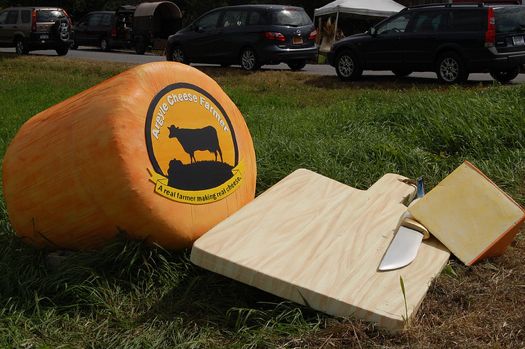
The annual Washington County Cheese Tour is coming up September 7 and 8 (10 am - 4 pm each day). The free self-guided tour includes stops at a handful of cheese-producing farms within a 10-mile radius. The farms will be giving out samples and talking about their cheese-making processes.
The participating farms this year: 3-Corner Field Farm (Shushan), Argyle Cheese Farmer (Argyle), Consider Bardwell Farm (West Pawlet, Vermont), Longview Farm (Argyle, Sugarloaf Farm (Fort Ann ), and Sweet Spring Farm (Argyle).
Tim went on the tour a few years back and shared a good recap with us about finding his "cheesy bliss" on the tour.
The Cheese Tour Premiere (with Beer)
In honor of the Washington County Cheese Tour, the Confectionery in Troy has lined up a "cheese tour premiere" -- a tasting of seven cow, goat and sheep cheeses from the Washington County farms -- Thursday night (tonight, August 29). The cheeses will be paired with craft beer.
The tasting from 6-8 pm tonight. Tickets are $30.
Cheddar on a boat
One more cheesy bit: Friday night at the Confectionery they'll be featuring a flight of three Wisconsin cheddars -- a 2-year, a 6-year and a 10-year cheddar. The cheese made its way from Wisconsin to Troy via tugboat. (And if you're wondering how cheddar cheese travels from Wisconsin to Troy on a tugboat, the answer is: Duncan Crary. Of course.)
photo: Tim Dawkins
Grazin'

Worth looking a little closer.
On first glance Grazin' in Hudson doesn't stand out much. The diner's metal and neon front is tucked in along the streetscape toward one end of Warren Street. Inside there are vinyl-lined booths and a jukebox. The menu? Burgers and a few other things. If anything, Grazin' just seems kind of retro.
But look closer and you'll notice what makes Grazin' stand out. That focused menu is truly farm to table -- as in, Grazin' gets its beef from its own farm. And Grazin's attention to how it sources its animal products has earned it the distinction of being the first Animal Welfare Approved restaurant in the country.
At the fair, competing for a ribbon
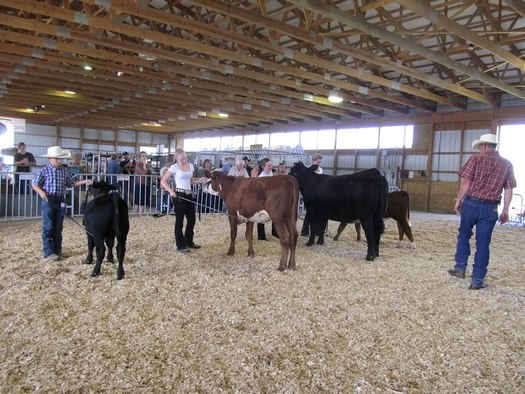
We're right in the middle of county fair season in the Capital Region. For a lot of people, that means rides on the Ferris wheel, games, and food on a stick.
But for some kids the county fair is the culmination of months, even years, of hard work. It's a step toward a future career. It's an opportunity to compete. It's a chance to win a ribbon.
How 'bout them (new) apples?
 Cornell has introduced two new apple varieties that are now growing around New York State and will eventually be popping up in stores:
Cornell has introduced two new apple varieties that are now growing around New York State and will eventually be popping up in stores:
SnapDragon: "[G]ets its juicy crispness from its Honeycrisp parent, and it has a spicy-sweet flavor." It's said to have a long shelf life. (The apples on the right are SnapDragons.)
RubyFrost: A later-ripening variety with "a beautiful skin and a nice sugar-acid balance" with a "crisp juiciness." Comparable to an Empire or Granny Smith.
The apples are available this summer, but there aren't that many being grown currently. Cornell says they should be showing up in stores in 2015.
Update: A Cornell spokesman says at least one orchard in this area is slated to have them at their farm stand this fall: Bowman Orchards in Rexford.
This bit about the apples' development, from a press release, caught our eye:
The two varieties have been a decade in the making, and how they've gone to market is a first for the Cornell apple-breeding program and the New York apple industry. Historically, public universities developed new apple breeds and released them to the industry freely. But in 1980, the Bayh-Dole Act gave universities the right to retain the intellectual property rights for their research, with limited plant-based royalties.
In May 2010, Cornell forged a partnership for a "managed release" with [New York Apple Growers], a new industry group, to establish an exclusive licensing agreement in North America for the two apple varieties. Growers pay royalties on trees purchased, acreage planted and fruit produced, and the income is used to market the new varieties and support Cornell's apple-breeding program.
Cornell has released 66 apple varieties since the 1890s, according to the press release, including the Cortland, Macoun, Empire and Jonagold.
Earlier on AOA: Lost and found apples
photo: Kevin Maloney / Cornell
About New York and maple syrup
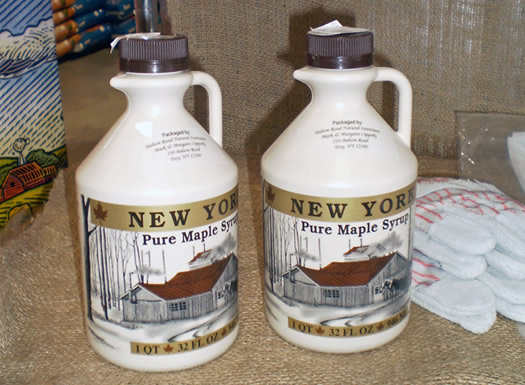
Two quarts of this year's haul.
Agricultural fact of the day: New York State produced 574,000 gallons of maple syrup during the 2013 season, according to a recently-released USDA report.
New York's production represented almost 18 percent of the national total. It was second only to Vermont, which produced 1.32 million gallons, almost 41 percent of the national total. (Don't mess with the Green Mountain state when it comes to maple syrup.)
Production in New York -- and all around the nation -- was way up this year compared to 2012 because of that year's oddly warm spring. The weather last year significantly shortened the amount of time farmers could gather sap -- just 24 days on average. This year the average season was 37 days.
Anyway, here are a few useless "facts" about the size of New York's maple syrup production:
Pick your own strawberry season 2013

From last year's crop.
Strawberry season in the greater Capital Region is starting! Many local pick-your-own farms are now open for the season, or will be very soon.
The recent weather hasn't done the farms any favors. We get the impression the hot/then cold/then hot/then dreary and very wet weather has held many strawberry crops back a bit. But it sounds like a few warm, sunny days should have the berries back on track. (And, as you might expect, fields are very wet right now -- so prepare accordingly.)
A typical strawberry season in this area usually only lasts a few weeks -- so don't wait too long.
Here are a handful of places in the greater Capital Region that you can pick your own strawberries. Know of a good place not on this list? Please share!
FarmieMarket expanding
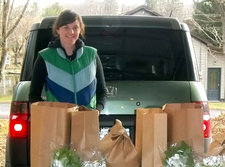 FarmieMarket -- the local online farmers' market -- announced today that it's expanding in the Hudson and Mohawk valleys. Starting June 12 it will serve customers in Columbia, Greene, Otsego, Herkimer, Montgomery and Fulton counties.
FarmieMarket -- the local online farmers' market -- announced today that it's expanding in the Hudson and Mohawk valleys. Starting June 12 it will serve customers in Columbia, Greene, Otsego, Herkimer, Montgomery and Fulton counties.
The roots of FarmieMarket were planted in 2010 when Sarah Gordon started Heldeberg Market to connect farms in the Hilltowns of Albany county with customers in Albany County via online ordering and weekly deliveries. She expanded to all four core counties of the Capital Region in 2011 under the FarmieMarket banner. Last year FM expanded to include Dutchess and Ulster via a base in Poughkeepsie.
Gordon grew up on a farm -- her dad runs a grassfed cattle farm in Knox. The online farmers market idea grew out of thinking about how to connect the farm with new customers.
Earlier on AOA:
+ Interesting in 2011: Sarah Gordon
+ Touring the Hilltowns, a farm at a time
photo courtesy of Sarah Gordon
A whey difficult problem
 There's an interesting article over at Modern Farmer about "the dark side" of Greek yogurt production: whey -- what's left over from the process of making yogurt. A clip from the article by Justin Elliot:
There's an interesting article over at Modern Farmer about "the dark side" of Greek yogurt production: whey -- what's left over from the process of making yogurt. A clip from the article by Justin Elliot:
For every three or four ounces of milk, Chobani and other companies can produce only one ounce of creamy Greek yogurt. The rest becomes acid whey. It's a thin, runny waste product that can't simply be dumped. Not only would that be illegal, but whey decomposition is toxic to the natural environment, robbing oxygen from streams and rivers. That could turn a waterway into what one expert calls a "dead sea," destroying aquatic life over potentially large areas. Spills of cheese whey, a cousin of Greek yogurt whey, have killed tens of thousands of fish around the country in recent years.
The scale of the problem--or opportunity, depending on who you ask--is daunting. The $2 billion Greek yogurt market has become one of the biggest success stories in food over the past few years and total yogurt production in New York nearly tripled between 2007 and 2013. New plants continue to open all over the country. The Northeast alone, led by New York, produced more than 150 million gallons of acid whey last year, according to one estimate.
And as the nation's hunger grows for strained yogurt, which produces more byproduct than traditional varieties, the issue of its acid runoff becomes more pressing. Greek yogurt companies, food scientists, and state government officials are scrambling not just to figure out uses for whey, but how to make a profit off of it.
As you know, New York State was the nation's biggest producer of yogurt in 2012, thanks in large part to the Greek yogurt factories in the state (including Chobani). So this is a pressing issue upstate -- especially as companies to continue to expand production. And there doesn't appear to be an easy answer.
Update: Chobani sent along a statement about the situation surrounding whey. It's in full after the jump.
Modern Farmer: Yep, that's the new publication based in Hudson.
Yogurt Empire State
 Dairy product fact of the day: New York was the nation's top producer of yogurt in 2012, the Cuomo admin reports.
Dairy product fact of the day: New York was the nation's top producer of yogurt in 2012, the Cuomo admin reports.
Producers in the Empire State turned out 692 million pounds of yogurt in 2012 -- up almost 25 percent over the year before. That pushed New York ahead of California, whose production fell almost 7 percent. Ferment that, Golden State.
New York's rise to the top is in large part due to the Greek-style yogurt boom. Chobani, the #1 brand of that type, has a large plant outside Oneonta -- that facility alone produces about half of the yogurt in the state* and consumes 10 percent of all the milk produced by New York dairy farms. And Fage -- the #2 Greek-style brand -- has a plant in Johnstown. And there are more plants in western New York. [USA Today] [Fage]
As the state's yogurt production surges, the state's milk production is having a hard time keeping up -- in part because of the costs of expanding dairy herds and regulations on milk pricing. The situation even has a name: "The Chobani Paradox." The milk crunch was one of the reasons Chobani built a new plant in Idaho. [WSJ] [Food Engineering Mag]
The situation has prompted state leaders to look for ways to help dairy farms expand. Example: Chuck Schumer has proposed federal tax breaks ( not without criticism) and immigration reform (to help dairy farms with workforce issues). And today the Cuomo admin announced it was relaxing some environmental rules on the number of cows that can be kept at large feeding operations. [Chuck Schumer office] [NYDN] [Slate] [Chuck Schumer office]
By the way: Chobani founder Hamdi Ulukaya is scheduled to be the speaker at the Sage Colleges' commencement in May.
* Estimate is based on production figures from USA Today and NYT in 2012.
Earlier and elsewhere:
+ Businessweek profile of Hamdi Ulukaya, which declares Upstate New York "the Silicon Valley of Yogurt"
+ Upstate is yogurt country
The art and science of maple sugaring

You might have a picture in mind when you think about maple syrup: a bucket hanging from a tree, smoke from the chimney atop a sugar shack, sap boiling in a cauldron.
While there are places where that picture still fits, modern maple sugaring also involves a range of advances in technology: pipelines, vacuums, evaporators, reverse osmosis machines.
Making maple syrup is a combination of science and craft. And in talking with two local sugarmakers, I found that there are a number of surprising factors that influence both the process and product in making maple syrup. From climate change to soil composition to bacteria in the sap, these are the elements that lead to some of the purest sweet stuff out there, much of which is coming from our backyard in upstate New York.
State of organics

Eight Mile Creek Farm, a certified organic farm in Westerlo.
Agriculture fact of the day: New York State had the third most certified organic farms* in the nation in 2011, with 597 -- according to the USDA. The two states ahead of it: California, with 1,898; and Oregon, with 870. New York ranks 4th in total acreage for organic farms. [USDA]
The state's certified organic farms produced products worth about $107 million. But almost half those farms had sales of less than $50,000 a year. About 40 had sales of more than $500,000.
The number one product from New York organic farms, by total sales value: organic milk, which makes up more than half of organic sales by farms (about $60 million). Certified organic milk represented about 1.5 percent of the state's total milk production by volume, and more than 2 percent by sales. [TU] [USDA]
* There are farms that adhere to many organic practices, but aren't necessarily certified organic. This number doesn't include them.
Earlier on AOA:
+ The organic milk shortage
+ Touring the Hilltowns, a farm at a time
Broccoli rabe from Migliorelli Farm
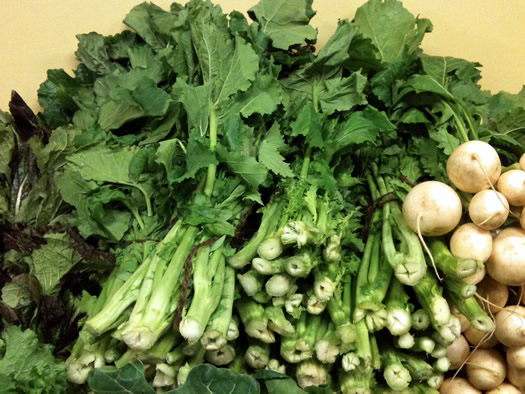
Green and leafy through the winter.
By the time November rolls around most community supported agriculture programs are closing up shop for the winter. Farmers' markets move indoors. And those who care about eating locally-produced fruits and vegetables get ready to bear the brunt of the next few months of winter storage crops.
And you know, it's not so bad. In fact, winter storage crops are some of the best things we grow in the region. Cabbage, onions, beets, potatoes, turnips, parsnips, rutabaga, carrots, celery root, sweet potatoes, and winter squash are all incredibly versatile. Which is a good. Because these are my new vegetable staples.
But wait. What's that big pile of greenery Migliorelli Farm has on its table? Oh, well they must come from a greenhouse. No? And they aren't hydroponic either. Well how do they do it then, and why is their broccoli rabe so good?
The special goat
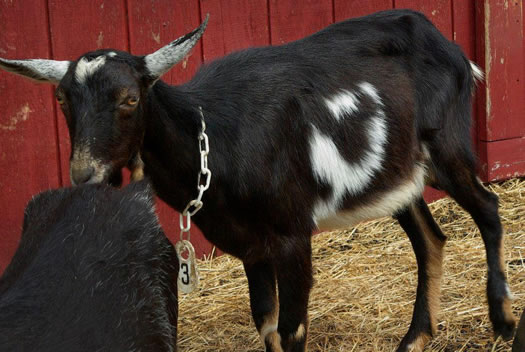
So, about those stories from the farm. We were talking with Regina and Frank from the goat milk dairy Goats and Gourmets last night, and they mention their "special goat." And we're like, oh... special how?
The photo above is of said goat. They say the mark is naturally occurring. And, yep, they call him Mickey.
photo courtesy of Goats and Gourmets
Farm-to-table dinner -- with the farmers! -- this Thursday
 Just a quick reminder that the AOA-organized farm-to-table dinner at Creo is this Thursday. The five-course dinner will feature ingredients from local farms -- and the farmers will be there to give short talks about their farms and how the ingredients were grown.
Just a quick reminder that the AOA-organized farm-to-table dinner at Creo is this Thursday. The five-course dinner will feature ingredients from local farms -- and the farmers will be there to give short talks about their farms and how the ingredients were grown.
It should be an interesting -- and delicious -- time. It starts at 6:30 pm.
Tickets for the five-course meal are $50, (drinks and tips not included). There's an optional wine pairing for $25. There are a handful of tickets remaining -- and you can buy them online.
The menu and the list of farms are after the jump.
AOA farm-to-table dinner at Creo -- with the farmers

Autumn is a great time of year to visit local farms and bring home an amazing harvest of meats, cheeses, and late season veggies.
So AOA and Creo are planning to gather some of that harvest for a 5-course farm-to-table dinner on Thursday, October 18. Chef Brian Bowden will create a menu using products from farms around the Capital Region -- and the farmers will be at the dinner to talk about the ingredients in each dish, how they're grown or produced, the thought that goes into them. The whole night should be fun, interesting, and delicious.
You'll also have an opportunity to pair the dishes with a handful of New York State wines.
Here are details on the menu, the farms, the wines, and how to sign up...
Old Sin Cider from Slyboro Ciderhouse
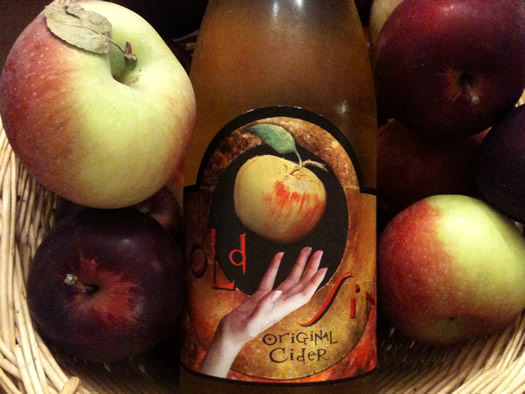
Sin has a creamy texture.
It's fall and we are in apple country. Huzzah! These are the golden months of life in the Capital Region.
While this year's apple crop may have suffered greatly from the mild winter, the early thaw, the spring frosts, hail, and drought, that shouldn't keep you from making the annual pilgrimage to an apple orchard.
There are apple cider donuts, of course -- a glorious treat that are best enjoyed as close to the source as possible. But there are some orchards that also offer other, more unusual, products from apples.
New York hops
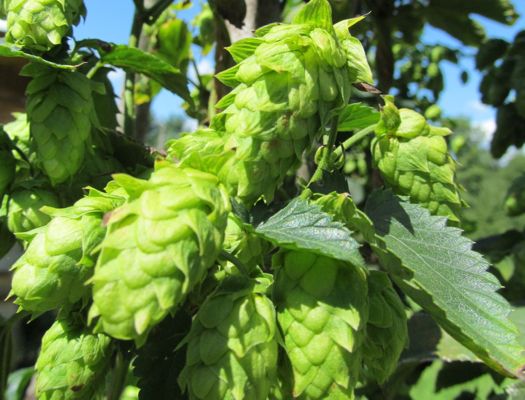
Little flower, big taste.
Beer enthusiasts showed up Brown's in Troy last week for the release of the brewery's annual fall Harvest IPA brew. What's so special about this brew? Well, for one thing, the hops used in the beer were grown right here in New York.
Brown's is part of a growing movement to restore New York to what it once was -- one of the country's leading hop producers.
Apple picking 2012
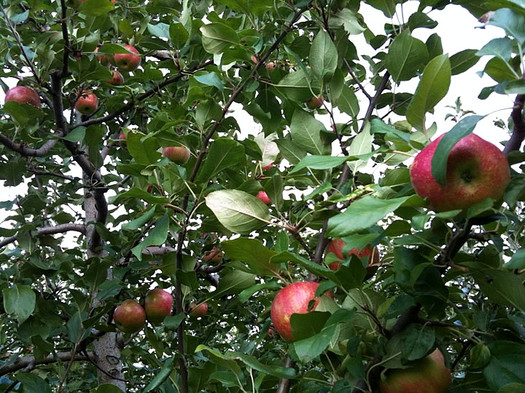
Harder to find this year.
The last days of summer usually mean the start of apple picking season in the Capital Region. But this year's warm winter, as well as April frosts and summer hailstorms, have forced many farms and orchards to choose whether to open to fall crowds at all.
"For some farmers it was the hailstorms, for some it was hailstorms and the frost, and for some it was the hailstorms, frost and the drought," said Gillian Sherington, owner of Smith Farms in Hudson. "You name it, we had it."
New York is wine country. And apple country. And maple syrup country. And cabbage country.
 Agricultural fact of the day, via the NYS Comptroller's Office: New York State was the second largest producer of wine in the nation in 2010, behind only California. The state produced 36 million gallons of wine that year. And as of 2012, the Empire State has 374 wineries -- more than triple the number it had in 2000.
Agricultural fact of the day, via the NYS Comptroller's Office: New York State was the second largest producer of wine in the nation in 2010, behind only California. The state produced 36 million gallons of wine that year. And as of 2012, the Empire State has 374 wineries -- more than triple the number it had in 2000.
A few more state agricultural facts:
+ Agriculture in the state produces $4.7 billion in products per year.
+ Milk accounts for half the agriculture sales in the state. (New York is the fourth leading producer of milk in the country.)
+ The state produced 553.67 million pounds of yogurt in 2011 -- more than double the amount it produced in 2008.
+ New York continues to rank second in the nation in apple production.
+ New York is the nation's second largest producer of maple syrup.
+ And it's also the nation's second largest producer of cabbage.
There are more bits in the state comptroller's report, which was released for the State Fair.
Talking peaches with Tom Maynard
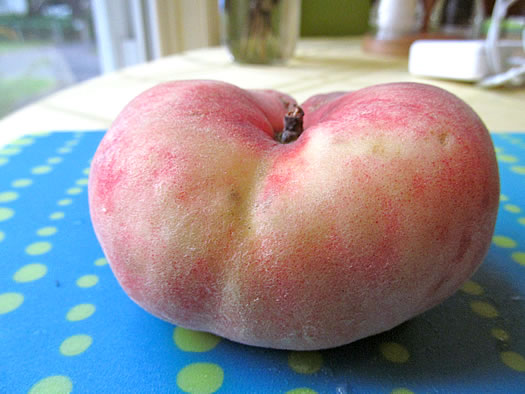
There's a secret to picking the best doughnut peaches.
Tom Maynard of Maynard Farms is a fixture at the Schenectady Greenmarket. He's been selling a wide variety of peaches, plums, nectarines and pears since the market started in 2008. And he grows some delicious fruit on his Hudson Valley farm.
"We try to deliver an honest-to-god good product to every customer who leaves here," he says. "My goal is for people to come here, buy our peaches and then come back next week saying, 'Wow, that was a really great peach.' Once they try it, they realize this isn't supermarket fruit."
Maynard has a friendly, outgoing presence, and you can often catch him talking about the finer points of fruit with customers.
I talked with him at the market recently for a quick guide on peaches and nectarines -- what separates the different varieties, how to make sure they're ripe, what the fuzz is called, and why you should look for the ugly ones.
Farm-to-Table Fundraiser in Rensselaerville
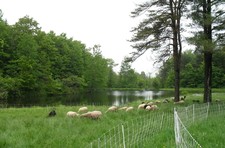 Could be a good time: FarmieMarket and the Chefs Consortium are teaming for "an evening of local food, music and fun" as a fundraiser for "farm-to-table programming" on August 26 at the Carey Center for Global Good in Rensselaerville (formerly the Rensselaerville Institute). Blurbage:
Could be a good time: FarmieMarket and the Chefs Consortium are teaming for "an evening of local food, music and fun" as a fundraiser for "farm-to-table programming" on August 26 at the Carey Center for Global Good in Rensselaerville (formerly the Rensselaerville Institute). Blurbage:
The Farm-To-Table Fundraiser is brought to you in partnership with the Chefs Consortium and FarmieMarket to benefit the Carey Center's programs to support agriculture and farmers in our local and regional community. Presently, the Carey Center is cultivating new programs for community composting, children's seed-to-fork education, farm brewing, green roof building, and local harvest culinary workshops. Additionally, the Carey Center is working with Baitsholts Farm to host an on-farm agricultural education program to teach new farmers and homesteaders the skills to thrive in the sustainable agriculture industry. [AOA adds: that's a photo of Baitsholts Farm on the right.]
The event will take place under a tent on the beautiful and historic grounds of the Carey Conference Center, featuring hors d'oeuvres and small plates of peak-harvest, local foods prepared by the area's top chefs, craft brewery samples, and music by Black Mountain Symphony.
Tickets are $40, and include food and craft beer samples.
Earlier on AOA: Touring the Hilltowns, a farm at a time
Peach Jack from Harvest Spirits

An experiment gone awry -- and then right.
Let's put the name aside for a moment.
What's important to know is that this is the essence of summertime in a glass. Because regardless of what anyone else says, nothing says summer as much as biting into a ripe and juicy peach as the nectar drips down your chin and arm. It's sweeter than the first sweet corn, it's juicier than even the ripest of strawberries, and it's more satisfying than the plumpest tomato. Nobody can be unhappy while eating a perfectly ripe peach.
This latest creation from Harvest Spirits in Valatie has been in the works for about a year, but was released just last week. Officially, it's a peach-flavored brandy, and it is indeed packed with the flavor of whole peaches. Calling it "peach flavored" however really does it a disservice, and actually it's not quite a brandy either. Technically, it's a peach infused applejack. But that too doesn't fully get to the heart of this spirit.
The story of how Peach Jack came into existence begins with an experiment gone awry.
Blueberry season 2012
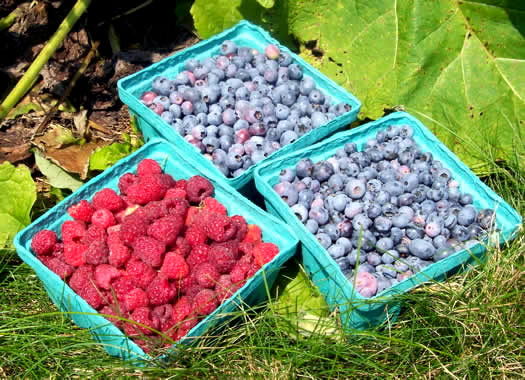
You can't have summer without blueberries. (OK, technically you can, but it's not recommended.)
Blueberry season at Capital Region farms is starting. July is usually prime time for blueberries in this area, but it appears the season is getting a little bit of an early start. One farm we talked with today said blues are about two weeks ahead of their normal schedule -- and "everything is coming in fast."
Here are a handful of places where you can pick your own (as well as other types of berries)...
Pick your own strawberry season 2012

Strawberries -- and strawberry fields -- at Samascott in Kinderhook.
Strawberry season has started! The local pick-your-own farms are open for the season. And it sounds like the crop has turned out OK, despite the weird spring, though some of the farms say the season will be short.
A typical strawberry season here usually only lasts a few weeks -- so don't wait. It sounds like this weekend, and especially the next week, will be the prime time.
Here are a handful of places in the greater Capital Region that you can pick your own strawberries. Know of a good place not on this list? Please share!
Touring the Hilltowns, a farm at a time
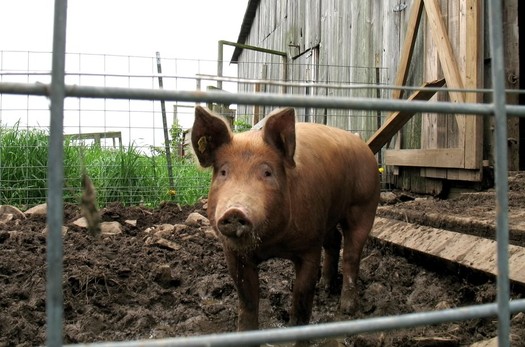
Well, hello.
We're always curious about where our food comes from. Not in an obsessive, super foodie kind of way -- it's more just being interested in how something growing in the ground, or grazing in a field, ends up on our plate.
So we recently asked Sarah Gordon, founder of FarmieMarket, if she could show us around a few farms out in the Albany County Hilltowns. Sarah knows a lot of the farmers there through her work with the market. But she also grew up there -- on a farm.
Sarah was nice enough to agree -- and last week we toured a handful of farms with her...
Chinese cabbage is a cool (weather) customer
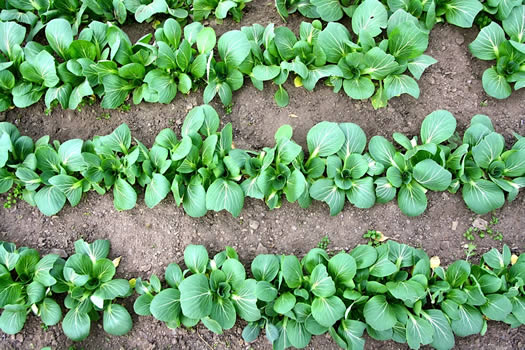
Pak choi at Kilpatrick Family Farm.
We're very happy to welcome From Scratch Club founder Christina Davis to AOA. (Also, over at FSC today: AOA Greg on baking bread. Yes, really.)
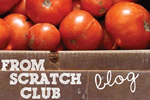 I don't know about you but I'm ready for the flavorful and colorful bounty of the summer months: strawberries, cherries, tomatoes, and much much more. We are already seeing a few glimpses of what's to come with wild-foraged ramps and fiddleheads, along with asparagus and spring peas.
I don't know about you but I'm ready for the flavorful and colorful bounty of the summer months: strawberries, cherries, tomatoes, and much much more. We are already seeing a few glimpses of what's to come with wild-foraged ramps and fiddleheads, along with asparagus and spring peas.
Until then -- while we're in "winter market" season -- you can still find some crisp cooler-weather greens at your local farmers market. To me, there is nothing better to dine on in the drawn-out grey months of winter and early-spring than fresh leafy greens: arugula, spinach, mustards, mesclun.
And then there are the Chinese brassicas: the broad, leafy greens pak choi and boy choy, and the densely-packed heads of Napa cabbage. Hands down, if you're looking for a taste of summer salad with the crunch of your summertime broad-leafed romaines and the slight watery texture of a head lettuce varieties, pak choi/bok choy has you covered for the remaining weeks of spring. I know I know, you usually add the choy to stir fries and fried rice dishes or you sauté with some garlic, hot pepper flakes and oil for a more Italian broccoli rabe-inspired side, but trust me when I say, eat it raw in salads or use as a cup for lettuce wraps. It will make you miss summer BBQs and park picnics just a little less.
We are lucky in the Capital Region to have a handful of farms that grow various leafy greens year-round, including Slack Hollow Farm (at the Troy Farmers' Market) and Kilpatrick Family Farm (at the Saratoga Farmers' Market), where I'm the community supported agriculture (CSA) coordinator.
I recently got a tour of how these greens are grown during the cold weather.
(Plus: a recipe for Asian greens salad.)
Lloyd Spear Honey

Buzzzzz.
Consider me converted.
Upon arriving to the area, my family was struck by the many varieties of local honey available at farm stands and farmers' markets. Part of eating local was enjoying these naturally sweet products.
Except there was a problem: granulation.
Really, it's not a problem. It's more of a nuisance. Because all honey eventually granulates, and it can be easily fixed by placing the jar in a pot of warm water until the crystals dissolve. But who wants to do that?
So we fell off the wagon and found some reasonably tasty supermarket honey. But recently all has not been well in bee-land. There have been all kinds of problems going on from colony collapse disorder to reports of fraudulent and contaminated honey being brought into the United States.
That, in addition to the rising price of supermarket honey and the very vocal fan base of local beekeeper Lloyd Spear led me to his stall at the Schenectady Greenmarket earlier this year. We've been buying Lloyd's honey ever since.
Recently when picking up a donation of honey he was making to the Jewish Food Festival, I had a chance to chat with him and find out what makes his stuff so good.
Goats & Gourmets
 Check it out: FarmieMarket, the local online farmers market, has added a dairy to its lineup of producers. And it's a goat dairy.
Check it out: FarmieMarket, the local online farmers market, has added a dairy to its lineup of producers. And it's a goat dairy.
From FarmieMarket's announcement of the addition of Goats & Gourmets, which is operated by Regina and Frank Bryant in Westerlo:
Regina, originally from Germany, has more than twenty years in the restaurant business working as a chef and restaurant owner in Florida and Manhattan. A few years ago, she decided to get out of the restaurant business and redirect her passion for gourmet food at the grassroots level by starting her own value-added goat dairy. So, in 2007 the Bryants moved to the Heldeberg Hilltowns, started a family, and dug in to build their farm.
After years of planning, practice and labor, they have grown their goat herd, built their own on-site cheese making facility, and earned their New York State inspections to begin selling their cheeses and other goat products to the public. The Bryants have skillfully built their goatherd to comprise a medley of all the beautiful dairy breeds, including Oberhasli, Toggenburg, Alpine, Saanen and LaMancha.
FarmieMarket is selling Goats & Gourments feta cheese in beet dressing, feta cheese in Italian dressing, dill medley chevre, and apricot-honey chevre.
Earlier on AOA:
+ Interesting in 2011: FarmieMarket's Sarah Gordon
+ Milk delivery options in the Capital Region
photo via FarmieMarket
The organic milk shortage
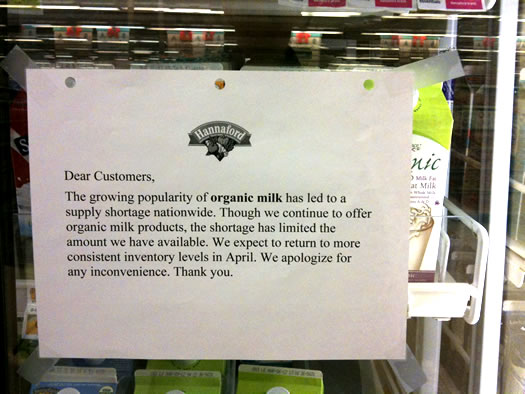
A sign on the dairy case at the Hannaford in Albany.
Over the last month or so we've noticed signs popping up on dairy cases at both Hannaford and Price Chopper noting that there's an organic milk shortage. And the shelves in the case have appeared rather bare at times. (We were the ones who took the last half-gallon of organic milk at the Slingerlands Price Chopper the other day. Sorry about that.)
So, what's going on?
Interesting in 2011: Sarah Gordon

Sarah Gordon and FarmieMarket's delivery van.
All this week we'll be highlighting some of the interesting people we've gotten to know over the past year.
We have a lot of respect for people who start something new from scratch. And that's just what Sarah Gordon did last year when she launched an online farmers' market connecting farms and customers in Albany County. Even more impressive: she's figured out how to grow it -- this year Sarah expanded the concept to become FarmieMarket, which includes farms and customers in all four of the Capital Region's core counties.
The idea for FarmieMarket comes from a very personal place for Sarah: her own family's farm in Knox. After using her digital savvy to help grow the family's grass-fed beef and hay farm, she realized she could also help other local family farms trying to carve out a spot in the market. This isn't just a business -- it's a cause. And a worthy one. Think about it: for every local family farm that's able to find its place in the modern world, there are ripple effects: open space preservation, economic development, better tasting food.
So, it's safe to say we're impressed. And we think after you hear a little bit from her, you will be, too.
Brunswick
Debuting soon: Brunswick, a documentary by Nate Simms about the tension between development and farming in the Rensselaer County town. From the blurbage:
Brunswick is a film about landscape change, told through the personal story of a farmer's lifelong connection to his now-threatened land. The film weaves together the plight of Sanford Bonesteel, an aging farmer in his 90s, with the dynamics of small-town politics as a residential development is planned on Sanford's former land.
The film takes place in Brunswick, New York, a small country town facing the challenge of balancing economic growth with the preservation of its rural character. It is a story both specific to Brunswick and yet recognizable to rural communities all over the United States.
All we've seen of the doc is what it's in the trailer embedded above, but it appears to be about the proposed Highland Creek development, that was to be built on farmland acquired in a deal involving the town supervisor. The development was the subject of multiple lawsuits and allegations of conflicts of interest. Bonesteel passed away at the end of 2008. [Troy Record 2008] [Wikipedia] [Troy Record 2006] [Troy Record 2008]
The first screening of the doc will be December 7 at the Spectrum. Tickets are $6.
Bonus bit: The soundtrack for the documentary was composed and performed by Matthew Carefully, who will be performing the music at Caffe Lena on December 4.
Turkey time at Coldwater Creek Farm
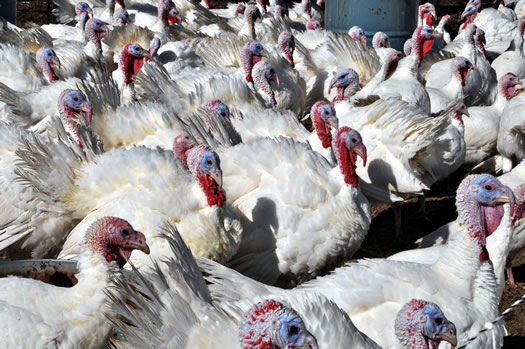
Gobble. Gobble.
James Kromer doesn't talk turkey.
So as he was driving 200 squawking, day-old chicks by car from a 50-year-old turkey farm in Boston to his Coldwater Creek Farm, his family's 26-acre property in southern Rensselaer County, he just cranked up the tunes.
"They just chirped the whole time. After about an hour and a half it bothered me so I turned up the radio and opened up the windows for some white noise," laughs Kromer, an accountant by day, who is marking his second year raising antibiotic-free, pasture-raised white Broad Breasted turkeys for Thanksgiving.
So, how does an accountant end up raising 200 turkeys?
Shaker Mountain Canning Co.

Kristen Greer wanted to to help increase access to fresh foods in New York City.
That's how it all began.
Greer, a New York City food policy advocate and part-time Rensselaer County resident also had a background in finance. She was volunteering with the board of Just Food to help bring more fresh foods into the city, when she discovered a need: a way for farmers and food entrepreneurs to turn their bounty into products that would last well past the growing season.
The idea for Shaker Mountain Canning Co. was born.
Today this small company near the Rensselaer County/Columbia County line cans everything from tomatoes, peppers and cucumbers to fruits, jams and butters and it's opened up a valuable conversation between farms and food producers.
Sowing oats (and wheat and rye) in urban Troy

Howard Stoner sows his oats, wheat and rye on a plot of land in Troy.
Howard Stoner is ready for winter. One look at his basement and you can tell. The place is stocked with 75 pounds of potatoes and other root vegetables from his community garden and 16 pounds of rye he grew on a small plot of land in downtown Troy.
Yep. Stoner is growing his own wheat, oats and rye on a 350 square foot plot near the RPI football field.
Concord grape season

Very... grape.
We were at Samascott Orchards this past weekend stocking up on apples when we noticed they also had concord grapes available for pick-your-own. We walked over to rows of vines and that's when it hit us: the strong aroma of grape -- and not just grape, but grape.
Old Chatham Sheepherding Company's Kinderhook Creek cheese

Sheepy.
Did you know that we had the largest sheep dairy in the United States fewer than 25 miles outside of Albany? And did you know that they make some of the finest sheep milk cheeses around?
I first learned about Old Chatham Sheepherding Company many years ago from an article in Saveur magazine on the splendor of their flock, the magnificence of their restaurant, and the comforts of their inn. It was a dream to eventually travel to their farm in northern Columbia County for dinner, but sadly all the other arms of the enterprise were shuttered before I could make the trip. Honestly, it's one of the great regrets of my life.
But it's September, and that means it's time to eat local. So I'm putting my regret aside -- with one of Old Chatham's newest offerings.
Touring Washington County's cheeses

Washington County -- cheesy... in the good way.
Back in the 90's there was this DuckTales cartoon where Uncle Scrooge goes swimming in his vault full of money. My childhood dream was doing the backstroke through that vault-- except it was completely filled with cheese -- though it probably would've been generic American.
These days my tastes are much more refined. Oh, I still would bathe myself in cheese if I could, but it would probably be aged in a cave somewhere off the coast of Spain instead of being manufactured in a plant in Boise.
And last weekend I found my cheesy bliss on a trip through Washington County.
Where to pick apples
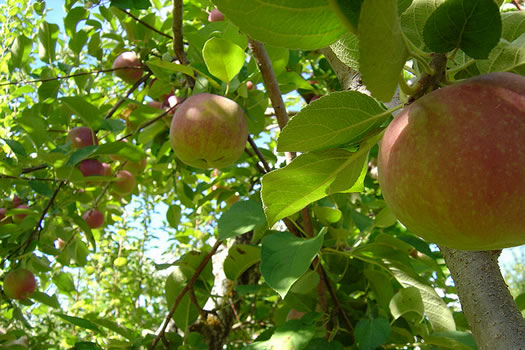
They're waiting for you.
We're right in the middle of prime apple picking season in upstate New York. So we've pulled together a map/listing of places in the Capital Region where you can pick your own.
Of course, apple picking isn't just about apples -- it's also about cider donuts (of course). So we've also noted which orchards are selling those, plus a few other bits of helpful information.
Is there a place you like to go that's not listed? Please share in the comments on this post. We'll add it.
photo: Flickr user Random Tree
Finding a connection to local farms at the fair
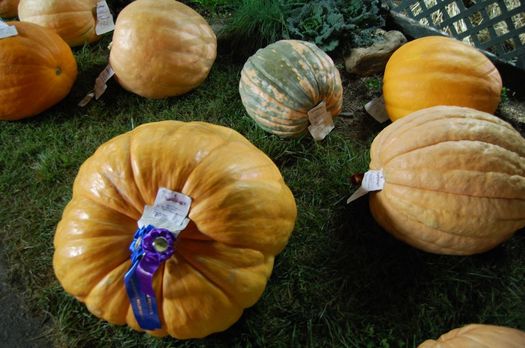
Prize-winning pumpkins from last week's Washington County Fair
I had plans this week to write about a time honored summer tradition -- the county fair. Then Hurricane Irene decided to set its sights on much of the East Coast. Now, that rivers and creeks have invaded our living spaces, our roadways, and our farmland, the topic becomes so much more poignant.
As we wave goodbye to summer through the haze of what nature's fury leaves behind, I'm thinking a lot about the people who make their living off of the land, and in turn provide so much for us. Their daily lives are a sacrifice, and things just became so much more complicated for them.
Signs of the times at the Columbia County Fair
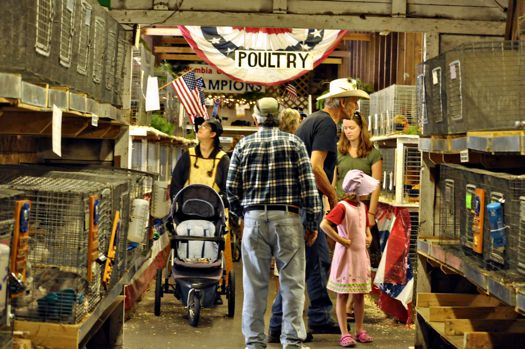
The poultry barn at the Columbia County Fair
They hop-skipped through the entrance gate and high-tailed it to their favorite place at the fair, the 4-H Cloverbuds barn at the Columbia County Fair, where all life's questions boil down into one chirping, downy-fluff yellow argument:
Which came first the chicken or the egg?
But in place of the newborn chicks we expected to find huddling under heat lamps in the familiar plexiglas pen, there were only two tiny bantams strutting about in the diminutive exhibit space.
FarmieMarket is now open
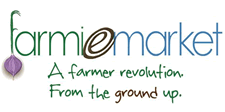 The expanded version of the local online farmers' market Heldeberg Market -- FarmieMarket -- opened today. The market now covers the four core counties of the Capital Region. ("Farmie" is a play on "foodie.")
The expanded version of the local online farmers' market Heldeberg Market -- FarmieMarket -- opened today. The market now covers the four core counties of the Capital Region. ("Farmie" is a play on "foodie.")
Heldeberg Market started just about a year ago. It and FarmieMarket are the creation of Sarah Avery Gordon -- she's an environmental consultant, and grew up on her parents' farm in Knox.
We've been interested in Heldeberg -- and now Farmie -- Market because it looks like an interesting bid to help develop the local food economy. So we bounced a few questions to Sarah today to hear about how things are going -- and where the market is headed.
Pick your own strawberry season 2011
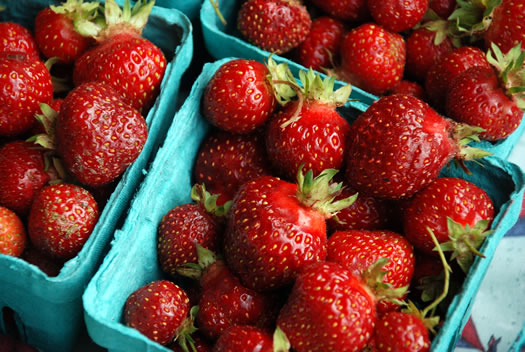
Berry good.
It is now, officially, strawberry season in New York. This year's season seems to be a little later than last. Many local farms are just opening for pick-your-own berries. But don't wait too long -- the season only lasts a few weeks.
Here are a handful of places in the greater Capital Region that you can pick your own strawberries. Know of a good place not on this list? Please share!
FarmieMarket
 Heldeberg Market, the online farmers' market that's been serving Albany County, announced today that it's expanding to the rest of the Capital Region -- under the name Farmie Market.
Heldeberg Market, the online farmers' market that's been serving Albany County, announced today that it's expanding to the rest of the Capital Region -- under the name Farmie Market.
The website says it will start taking orders in July. (And it explains that "farmie" is a play on "foodie.")
Heldeberg Market started last summer. It's the creation of Sarah Avery Gordon -- she's an environmental consultant, and grew up on her parents' farm in Knox.
Wellington's herbs, spices and community

Wellington's
Carolyn and Frederick Wellington are passionate people who love to share their passion.
Twelve years ago they retired from their jobs in health care and higher education to open Wellington's Herbs and Spices - a 45 acre farm, store and tea shop in Schoharie. And they haven't stopped working since.
Now they grow and sell fresh and dried herbs, certified organic vegetables, baked goods and lots of specialty items (think lavender vinegar and lemon verbena sugar). They also build community.
They converted one of their barns to a showroom for local artists, and transformed another part into meeting space for local non-profits.
Their newest program, one that they're starting this year, allows other people to work on the farm, in exchange for organic vegetables.
The cabbage patch
 As the debate over whether onions or corn should become the official state vegetable plows ahead, the New York Farm Bureau interjects with this important fact: the state's biggest vegetable crop is actually... cabbage, at $110 million per year.
As the debate over whether onions or corn should become the official state vegetable plows ahead, the New York Farm Bureau interjects with this important fact: the state's biggest vegetable crop is actually... cabbage, at $110 million per year.
The Empire State's annual cabbage harvest ranks second in the nation, according to the Farm Bureau. The primary cabbage producing counties are in western New York.
The state's number one crop? Apples, at $185 million per year.
By the way: While we're on the topic of an official state vegetable, why can't we pick something cool like Romanesco broccoli (you know the fractal one). Or, give a nod to the growing small organic farm movement here with something like heirloom radishes or pea shoots. Even cabbage shows a certain desire to be different. Anything but corn.
[via @nickconfessore]
photo: Flickr user Nick Saltmarsh
Milk delivery options in the Capital Region
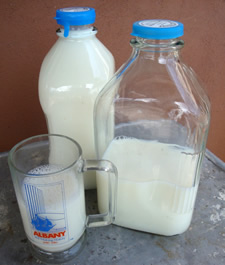 I grew up with a milk-box on my front steps, and it was an incredibly useful thing. It was my oven when I played house: The grey metal box baked pebble cakes to perfection. When the porch was my covered wagon, the box was the driver's seat.
I grew up with a milk-box on my front steps, and it was an incredibly useful thing. It was my oven when I played house: The grey metal box baked pebble cakes to perfection. When the porch was my covered wagon, the box was the driver's seat.
It also held milk.
The milkman would come by in the afternoons once a week. He had a '70s mustache -- it was the '70s, after all -- and a yellow cap. If we were home when he came, we could buy chocolate milk from him, right off the truck. Barefoot in the grass, and someone drives up and brings you chocolate milk: That's the way childhood is supposed to be.
I always liked getting milk delivery. It made milk somehow more special than the other foods. It was the only one, after all, that came straight to my house.
I haven't pulled my pebble cake recipe out of the files for a long time now. But as the owner of a porch, it seemed right to me that the porch have a milk-box. The milk we have delivered is sweet and fresh and flavorful like no milk I've ever had -- including what I remember from my childhood. (New York cows, I salute you.)
It's also more expensive. We think of it as our weekly contribution to the Support A Local Farm fund. And we love that it comes in heavy reusable glass bottles -- and that we don't have to throw a plastic gallon jug into the recycling bin every week.
The Capital Region's home milk delivery options have expanded in recent years. What follows are some dairies that bring the milk from the cow to your porch -- and a little about how they do it.
100% real maple syrup
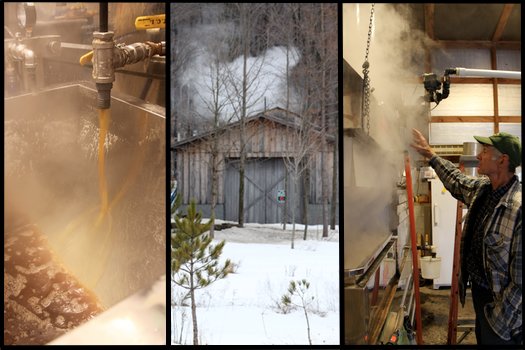
Real maple syrup. That's what we're talkin' about.
People are passionate about maple syrup. Take these comments from the AOA crowd in Crystal's post about the best diner breakfasts:
Lfox18 says: "If you need to - charge me more but give me the real maple syrup."
Bob adds: "Pancakes just ain't pancakes without the real maple syrup."
And our favorite by Leigh: "I feel a little odd admitting it...but I actually carry real maple syrup in my purse when going out to breakfast."
Crystal even said within the story: "We can't emphasize enough to every diner out there how gross it is to try and pass off corn syrup as maple syrup. Not the same, not even close!"
We agree.
And this is the time of year when it's made. So in honor of the delicious, sticky, perfect-topping-for-pancakes-and-french toast, we took a visit to the Nightingale Maple Farm in Amsterdam to see how it's done.
Right to Farm law

So the other day I was heading down Route 50 near Ballston when I saw the sign above.
I'd never seen one before -- and I wondered what it meant. I asked around -- but no one else I checked with seemed to know either. So I did a little digging.
It turns out it's a concept that's been around for awhile, and it's meant to preserve rural character and give farmers rights when new development moves in.
It's likely enacted in a town near you.
Even if you don't live near a farm it's interesting and worth understanding.
Chicken sale at local online farmers' market
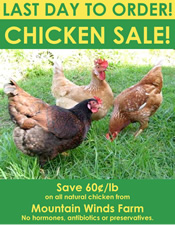 Heldeberg Market -- the local online farmers' market -- has a sale on chicken this week. "All-natural ... anti-biotic, hormone and preservative free" whole chickens from Mountain Winds Farm are roughly $3/pound.
Heldeberg Market -- the local online farmers' market -- has a sale on chicken this week. "All-natural ... anti-biotic, hormone and preservative free" whole chickens from Mountain Winds Farm are roughly $3/pound.
Sure, that's more expensive than what you'd pay for a "regular" chicken in the supermarket, but for a local "all natural" bird, that seems like not a bad price. And if you're wondering what you'd do with a whole chicken, we have one word for you: soup.
If you want a chicken this week, you have to order by the end of today (delivery is on Thursday).
Speaking of Heldeberg Market... Has anyone used this online market? How was the experience? Were the products good?
Earlier on AOA:
+ Details from Heldeberg Market's launch this past summer.
+ Changing Albany's chicken laws
Good corn mazes?
 With an eye to the season, MattW emails:
With an eye to the season, MattW emails:
Where are the area's best corn mazes?
I'm looking for a challenging, elaborate, whimsical, no child's play corn maze in the area.
Got a suggestion for MattW? Please share!
photo: Flickr user Art Institute of Portland
Peachy

Tastes like summer.
Before the taco this weekend, we stopped at Golden Harvest in Valatie for some peaches. They were great -- juicy and sweet, not like the peach-like objects we often find in the supermarket. (Say all you want about the advantages of local food, sometimes the best selling point is that it just plain tastes better.) We're looking forward to scoring some more peaches this weekend at the farmers market.
We would normally be right in the middle of peach season, but it -- like a lot of crops -- is about two weeks early this summer. So don't sleep on the peaches.
The early warm weather this year has also apparently moved the apple crop along, too. The New York Apple Association reports that some early season apples should be ready by mid-August (so, maybe this weekend). And all the sunny weather should result in sweeter apples.
It has us thinking about apple picking...
Beautiful -- and cheap! -- local flowers
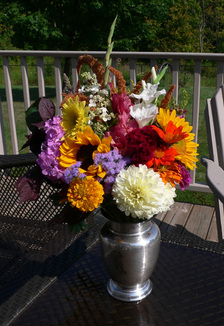 EAC emails with what sounds like a great deal on local flowers:
EAC emails with what sounds like a great deal on local flowers:
I commented a couple of days ago regarding pick-your-own-vegetables in the area, and mentioned the $5 bouquets at Oreshan's on Route 9.
Today I got the kid out of the house early enough to snap one up! At the stand they sit on a picnic bench in old tatty labeled large cans... I wish I had something like that at home. There were several cars there first thing this morning. Took a photo of the bouquet on the back deck.
See? Oreshan's is the best. I'm also enjoying the 40 cent gladiola stems in vases all over the house.
Oreshan's is at 1242 Loudon Road (Route 9) in Latham.
Click on the flowers for a better look.
Pick-your-own vegetables?
 Brian emails:
Brian emails:
Any suggestions on pick your own veggies? My garden sort of pooped out this year and I want tomatoes, cukes, zukes, beans...
Hmm... there are a bunch a pick-your-own fruit places, but we're not sure about PYO vegetables.
Your best bet is probably to just hit up a farmers' market or a farm stand. Of course, that doesn't give you twisting-off-the-vine experience.
So, anyone have suggestions for Brian? We'll expand this a bit to include good farm stands (quality, selection). Please share!
It's strawberry time!

Berry good!
Update: Here's information for this year (2011).
_____
The warm spring has resulted in an early strawberry season this year. In fact, we are at the peak of the season, according to the New York State Berry Growers Association.
Here are a handful of places in the greater Capital Region that you can pick your own strawberries. Know of a good place not on this list? Please share!
Heldeberg Market
 A new local online farmers market, called Heldeberg Market, launched today. Here's the setup:
A new local online farmers market, called Heldeberg Market, launched today. Here's the setup:
- On the market's website, you pick a basket of products available from farmers in the hill towns of Albany County -- everything from herbs to maple syrup to wool
- Pay online
- Orders submitted by Tuesday at midnight are delivered the Thursday of that week to either your workplace (during the day) or home (during the evening). There's free delivery for workplaces that have five or more orders.
Seth and his sauerkraut

Sausage recommended, but not required.
So about a year ago, some friends turned me on to Hawthorne Valley's lacto-fermented sauerkraut and now, no other kraut can compare.
It's crispy, it's tangy, it's almost, well, effervescent. It's eat-straight-from-the-jar-good. No sausage required. It will give your Oktoberfest that certain je ne sais quoi. ]
And it's the brain child of a guy called Sauerkraut Seth.
No, really. That's what they call him.
It's pick-your-own blueberry time
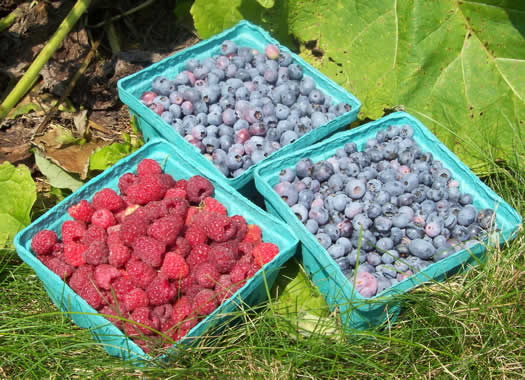
Summer desserts start here.
We're right in the middle of the local blueberry season. Here are a handful of places you can pick your own blueberries (and maybe raspberries, too).
The Menands Farmers' Market
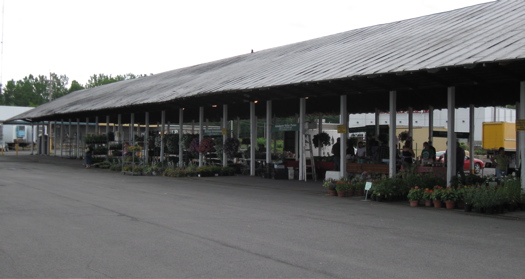
The Capital District Farmers Market in Menands
Farmers' markets are definitely one of my favorite things about summer and we're pretty lucky here in the Capital Region to have so many to choose from.
And while I'm trying not to discriminate or be a hater, everybody has markets that they're more partial to. High on my list is The Capital District Farmers Market in Menands.
Shopping the farmers' markets
 Local farmers' markets are moving outdoors this weekend and there's lots of yummy, seasonal food to be had.
Local farmers' markets are moving outdoors this weekend and there's lots of yummy, seasonal food to be had.
This week's bounty includes ramps, asparagus, arugula, spinach and all sorts of seedlings.
Here's a breakdown of what you'll find at the weekend markets in Troy, Schenectady and Saratoga. Don't forget, the Troy market moves to its new location in Riverfront Park this week.
Next week we'll have more from these and other area markets.
Locally grown sweaters
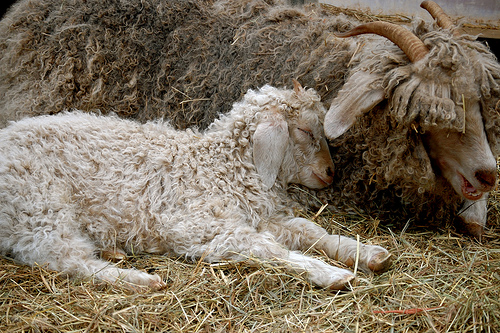
Sheep are good at keeping warm.
OK, not sweaters exactly, but the um, ingredients for them.
After seeing the recent post about farm shares, Ellen sent along a link to a yarn share based in the Hudson Valley.
Yep, it's like a CSA for knitters. Emailed Ellen: "It's the coolest thing. I know there are lots of knitters, crocheters and spinners in the Capital Region who would love to buy yarn this way and support a working farm."
The farm share started with a farm on Martha's Vineyard and later expanded to the Hudson Valley. And get this: one of the people who runs the share is former Columbia County state Assemblyman Pat Manning.
Bonus yarn info: Ellen says you can also buy locally raised yarn at Saratoga Needle Arts.
(Thanks, Ellen!)
photo: Martha's Vineyard Fiber Farm and Hudson Valley Fiber Farm

... said KGB about Drawing: What's something that brought you joy this year?